Caroline Leavitt's Blog, page 22
March 15, 2018
Chris Bohjalian talks about THE FLIGHT ATTENDANT, flawed heroines, the bliss of writing, and so much more
<!-- /* Font Definitions */ @font-face {font-family:"MS 明朝"; mso-font-charset:78; mso-generic-font-family:auto; mso-font-pitch:variable; mso-font-signature:1 134676480 16 0 131072 0;} @font-face {font-family:"Cambria Math"; panose-1:2 4 5 3 5 4 6 3 2 4; mso-font-charset:0; mso-generic-font-family:auto; mso-font-pitch:variable; mso-font-signature:-536870145 1107305727 0 0 415 0;} @font-face {font-family:Cambria; panose-1:2 4 5 3 5 4 6 3 2 4; mso-font-charset:0; mso-generic-font-family:auto; mso-font-pitch:variable; mso-font-signature:-536870145 1073743103 0 0 415 0;} /* Style Definitions */ p.MsoNormal, li.MsoNormal, div.MsoNormal {mso-style-unhide:no; mso-style-qformat:yes; mso-style-parent:""; margin:0in; margin-bottom:.0001pt; mso-pagination:widow-orphan; font-size:12.0pt; font-family:Cambria; mso-ascii-font-family:Cambria; mso-ascii-theme-font:minor-latin; mso-fareast-font-family:"MS 明朝"; mso-fareast-theme-font:minor-fareast; mso-hansi-font-family:Cambria; mso-hansi-theme-font:minor-latin; mso-bidi-font-family:"Times New Roman"; mso-bidi-theme-font:minor-bidi;} p.MsoFooter, li.MsoFooter, div.MsoFooter {mso-style-priority:99; mso-style-link:"Footer Char"; margin:0in; margin-bottom:.0001pt; mso-pagination:widow-orphan; tab-stops:center 3.25in right 6.5in; font-size:12.0pt; font-family:Cambria; mso-ascii-font-family:Cambria; mso-ascii-theme-font:minor-latin; mso-fareast-font-family:"MS 明朝"; mso-fareast-theme-font:minor-fareast; mso-hansi-font-family:Cambria; mso-hansi-theme-font:minor-latin; mso-bidi-font-family:"Times New Roman"; mso-bidi-theme-font:minor-bidi;} p.MsoListParagraph, li.MsoListParagraph, div.MsoListParagraph {mso-style-priority:34; mso-style-unhide:no; mso-style-qformat:yes; margin-top:0in; margin-right:0in; margin-bottom:0in; margin-left:.5in; margin-bottom:.0001pt; mso-add-space:auto; mso-pagination:widow-orphan; font-size:12.0pt; font-family:Cambria; mso-ascii-font-family:Cambria; mso-ascii-theme-font:minor-latin; mso-fareast-font-family:"MS 明朝"; mso-fareast-theme-font:minor-fareast; mso-hansi-font-family:Cambria; mso-hansi-theme-font:minor-latin; mso-bidi-font-family:"Times New Roman"; mso-bidi-theme-font:minor-bidi;} p.MsoListParagraphCxSpFirst, li.MsoListParagraphCxSpFirst, div.MsoListParagraphCxSpFirst {mso-style-priority:34; mso-style-unhide:no; mso-style-qformat:yes; mso-style-type:export-only; margin-top:0in; margin-right:0in; margin-bottom:0in; margin-left:.5in; margin-bottom:.0001pt; mso-add-space:auto; mso-pagination:widow-orphan; font-size:12.0pt; font-family:Cambria; mso-ascii-font-family:Cambria; mso-ascii-theme-font:minor-latin; mso-fareast-font-family:"MS 明朝"; mso-fareast-theme-font:minor-fareast; mso-hansi-font-family:Cambria; mso-hansi-theme-font:minor-latin; mso-bidi-font-family:"Times New Roman"; mso-bidi-theme-font:minor-bidi;} p.MsoListParagraphCxSpMiddle, li.MsoListParagraphCxSpMiddle, div.MsoListParagraphCxSpMiddle {mso-style-priority:34; mso-style-unhide:no; mso-style-qformat:yes; mso-style-type:export-only; margin-top:0in; margin-right:0in; margin-bottom:0in; margin-left:.5in; margin-bottom:.0001pt; mso-add-space:auto; mso-pagination:widow-orphan; font-size:12.0pt; font-family:Cambria; mso-ascii-font-family:Cambria; mso-ascii-theme-font:minor-latin; mso-fareast-font-family:"MS 明朝"; mso-fareast-theme-font:minor-fareast; mso-hansi-font-family:Cambria; mso-hansi-theme-font:minor-latin; mso-bidi-font-family:"Times New Roman"; mso-bidi-theme-font:minor-bidi;} p.MsoListParagraphCxSpLast, li.MsoListParagraphCxSpLast, div.MsoListParagraphCxSpLast {mso-style-priority:34; mso-style-unhide:no; mso-style-qformat:yes; mso-style-type:export-only; margin-top:0in; margin-right:0in; margin-bottom:0in; margin-left:.5in; margin-bottom:.0001pt; mso-add-space:auto; mso-pagination:widow-orphan; font-size:12.0pt; font-family:Cambria; mso-ascii-font-family:Cambria; mso-ascii-theme-font:minor-latin; mso-fareast-font-family:"MS 明朝"; mso-fareast-theme-font:minor-fareast; mso-hansi-font-family:Cambria; mso-hansi-theme-font:minor-latin; mso-bidi-font-family:"Times New Roman"; mso-bidi-theme-font:minor-bidi;} span.FooterChar {mso-style-name:"Footer Char"; mso-style-priority:99; mso-style-unhide:no; mso-style-locked:yes; mso-style-link:Footer;} .MsoChpDefault {mso-style-type:export-only; mso-default-props:yes; font-family:Cambria; mso-ascii-font-family:Cambria; mso-ascii-theme-font:minor-latin; mso-fareast-font-family:"MS 明朝"; mso-fareast-theme-font:minor-fareast; mso-hansi-font-family:Cambria; mso-hansi-theme-font:minor-latin; mso-bidi-font-family:"Times New Roman"; mso-bidi-theme-font:minor-bidi;} @page WordSection1 {size:8.5in 11.0in; margin:1.0in 1.25in 1.0in 1.25in; mso-header-margin:.5in; mso-footer-margin:.5in; mso-paper-source:0;} div.WordSection1 {page:WordSection1;} /* List Definitions */ @list l0 {mso-list-id:522934649; mso-list-type:hybrid; mso-list-template-ids:-796213606 1939876946 67698713 67698715 67698703 67698713 67698715 67698703 67698713 67698715;} @list l0:level1 {mso-level-start-at:6; mso-level-text:"%1\)"; mso-level-tab-stop:none; mso-level-number-position:left; text-indent:-.25in; mso-ansi-font-weight:bold;} @list l0:level2 {mso-level-number-format:alpha-lower; mso-level-tab-stop:none; mso-level-number-position:left; text-indent:-.25in;} @list l0:level3 {mso-level-number-format:roman-lower; mso-level-tab-stop:none; mso-level-number-position:right; text-indent:-9.0pt;} @list l0:level4 {mso-level-tab-stop:none; mso-level-number-position:left; text-indent:-.25in;} @list l0:level5 {mso-level-number-format:alpha-lower; mso-level-tab-stop:none; mso-level-number-position:left; text-indent:-.25in;} @list l0:level6 {mso-level-number-format:roman-lower; mso-level-tab-stop:none; mso-level-number-position:right; text-indent:-9.0pt;} @list l0:level7 {mso-level-tab-stop:none; mso-level-number-position:left; text-indent:-.25in;} @list l0:level8 {mso-level-number-format:alpha-lower; mso-level-tab-stop:none; mso-level-number-position:left; text-indent:-.25in;} @list l0:level9 {mso-level-number-format:roman-lower; mso-level-tab-stop:none; mso-level-number-position:right; text-indent:-9.0pt;} @list l1 {mso-list-id:1165248113; mso-list-type:hybrid; mso-list-template-ids:-1642556678 67698705 67698713 67698715 67698703 67698713 67698715 67698703 67698713 67698715;} @list l1:level1 {mso-level-text:"%1\)"; mso-level-tab-stop:none; mso-level-number-position:left; margin-left:6.25in; text-indent:-.25in;} @list l1:level2 {mso-level-number-format:alpha-lower; mso-level-tab-stop:none; mso-level-number-position:left; margin-left:6.75in; text-indent:-.25in;} @list l1:level3 {mso-level-number-format:roman-lower; mso-level-tab-stop:none; mso-level-number-position:right; margin-left:7.25in; text-indent:-9.0pt;} @list l1:level4 {mso-level-tab-stop:none; mso-level-number-position:left; margin-left:7.75in; text-indent:-.25in;} @list l1:level5 {mso-level-number-format:alpha-lower; mso-level-tab-stop:none; mso-level-number-position:left; margin-left:8.25in; text-indent:-.25in;} @list l1:level6 {mso-level-number-format:roman-lower; mso-level-tab-stop:none; mso-level-number-position:right; margin-left:8.75in; text-indent:-9.0pt;} @list l1:level7 {mso-level-tab-stop:none; mso-level-number-position:left; margin-left:9.25in; text-indent:-.25in;} @list l1:level8 {mso-level-number-format:alpha-lower; mso-level-tab-stop:none; mso-level-number-position:left; margin-left:9.75in; text-indent:-.25in;} @list l1:level9 {mso-level-number-format:roman-lower; mso-level-tab-stop:none; mso-level-number-position:right; margin-left:10.25in; text-indent:-9.0pt;} ol {margin-bottom:0in;} ul {margin-bottom:0in;} </style><br /><div class="MsoListParagraph" style="margin-left: 0in; mso-add-space: auto; mso-list: l1 level1 lfo1; text-indent: 0in;"><br /><br /><br /><div class="separator" style="clear: both; text-align: center;"><a href="https://3.bp.blogspot.com/-_hr0dXPtga..." imageanchor="1" style="margin-left: 1em; margin-right: 1em;"><img border="0" data-original-height="475" data-original-width="313" height="320" src="https://3.bp.blogspot.com/-_hr0dXPtga..." width="210" /></a></div><br /><br /><div class="separator" style="clear: both; text-align: center;"><b style="mso-bidi-font-weight: normal;"><span style="mso-bidi-font-family: Cambria; mso-bidi-theme-font: minor-latin; mso-fareast-font-family: Cambria; mso-fareast-theme-font: minor-latin;"><span style="mso-list: Ignore;"><span style="font: 7.0pt "Times New Roman";"><a href="https://2.bp.blogspot.com/-L7u1p7w0Pr..." imageanchor="1" style="margin-left: 1em; margin-right: 1em;"><img border="0" data-original-height="1083" data-original-width="912" height="320" src="https://2.bp.blogspot.com/-L7u1p7w0Pr..." width="269" /></a></span></span></span></b></div><br /><br /><br /><br /><b style="mso-bidi-font-weight: normal;"><span style="mso-bidi-font-family: Cambria; mso-bidi-theme-font: minor-latin; mso-fareast-font-family: Cambria; mso-fareast-theme-font: minor-latin;"><span style="mso-list: Ignore;"><span style="font: 7.0pt "Times New Roman";"> </span></span></span></b>“<i>Filled with turbulence and sudden plunges in altitude, ‘The Flight Attendant’ is a very rare thriller whose penultimate chapter made me think to myself, ‘I didn’t see that coming.’ The novel — Bohjalian’s 20th — is also enhanced by his deftness in sketching out vivid characters and locales and by his obvious research into the realities of airline work.”<br /> <b>— Maureen Corrigan, The Washington Post</b></i><br /><i><b><br /></b></i><br /><br /><i><b><a href="http://chrisbohjalian.com/">C... Bohjalian'</a>s</b> brand new novel, “<a href="http://chrisbohjalian.com/the-flight-... Flight Attendant,</a>” just landed. I couldn't resist opening with that play on words. I first met Chris on a stage at Rainy Day Books. Pictures of You was just published, I was on tour, and I was NERVOUS. Chris was so funny, warm, supportive. AND he wore bright yellow sneakers in honor of my red boots. We had a blast that day, and I've loved him ever since.</i><br /><i><br /></i><i>His latest novel, THE FLIGHT ATTENDANT is smart, surprising, and I guarantee you'll be up all night because what's sleep compared to tension and suspense?</i><br /><br /><br /><i>Ready for the impressive bio?<br /><br />His books have been chosen as Best Books of the Year by the Washington Post, the St. Louis Post-Dispatch, the Hartford Courant, the Milwaukee Journal-Sentinel, Publishers Weekly, Library Journal, Kirkus Reviews, Bookpage, and Salon.</i><br /><i> </i><i>His awards include the Walter Cerf Medal for Outstanding Achievement in the Arts; the ANCA Freedom Award for his work educating Americans about the Armenian Genocide; the ANCA Arts and Letters Award for The Sandcastle Girls, as well as the Saint Mesrob Mashdots Medal; the New England Society Book Award for The Night Strangers; the New England Book Award; Russia’s Soglasie (Concord) Award for The Sandcastle Girls; a Boston Public Library Literary Light; a finalist for the Lambda Literary Award for Trans-Sister Radio; a Best Lifestyle Column for “Idyll Banter” from the Vermont Press Association; and the Anahid Literary Award. His novel, Midwives,was a number one New York Times bestseller, a selection of Oprah’s Book Club, and a New England Booksellers Association Discovery pick. He is a Fellow of the Vermont Academy of Arts and Sciences.<br /><br />Thank you, thank you, for everything, Chris.</i><br /><br /><br /><b style="mso-bidi-font-weight: normal;"><span style="mso-bidi-font-family: Cambria; mso-bidi-theme-font: minor-latin; mso-fareast-font-family: Cambria; mso-fareast-theme-font: minor-latin;"><span style="mso-list: Ignore;"><span style="font: 7.0pt "Times New Roman";"> </span></span></span></b><b style="mso-bidi-font-weight: normal;">I always want to know what was haunting you that made you know that now was the time to write this novel.</b></div><div class="MsoNormal"><br /></div><div class="MsoNormal"><span style="font-family: "times new roman";">I didn’t necessarily know “this” was the time for this novel.<span style="mso-spacerun: yes;"> </span>Sometimes I seem to get lucky and sense what’s out there in the zeitgeist.<span style="mso-spacerun: yes;"> </span>But I wasn’t thinking when I began writing what would become <i style="mso-bidi-font-style: normal;">The Flight Attendant</i>in March 2016, “Russian espionage and election meddling will be a news story in March 2018.”<span style="mso-spacerun: yes;"> </span>I wish I had that kind of foresight.<span style="mso-spacerun: yes;"> </span></span></div><div class="MsoNormal"><span style="font-family: "times new roman";"><span style="mso-tab-count: 1;"> </span> </span><br /><span style="font-family: "times new roman";">But I have always been fascinated with the Russian soul and loved Russian literature.<span style="mso-spacerun: yes;"> </span>And as you know from our wonderful events together in 2011 when you were touring for your magnificent novel, <i style="mso-bidi-font-style: normal;">Pictures of You,</i> and I was touring for <i style="mso-bidi-font-style: normal;">The Night Strangers</i>, I’ve always been fascinated by aviation and air travel.<span style="mso-spacerun: yes;"> </span>I am in awe of flight attendants and pilots.</span></div><div class="MsoNormal"><span style="font-family: "times new roman";"><span style="mso-tab-count: 1;"> </span></span><br /><span style="font-family: "times new roman";"><span style="mso-tab-count: 1;"> </span>And one evening, it all came together at – appropriately – a bar.<span style="mso-spacerun: yes;"> </span>I had just flown into JFK from Armenia via Moscow, and I was meeting a friend for dinner at an Armenian restaurant we love in Manhattan.<span style="mso-spacerun: yes;"> </span>I was an hour early and so I settled with a glass of arak, a Middle Eastern anise-flavored alcohol I love.<span style="mso-spacerun: yes;"> </span>And my mind was thinking about air travel and Russia, and I suddenly I was scribbling frantically on every piece of scrap paper the bartender had handy.<span style="mso-spacerun: yes;"> </span>The premise?<span style="mso-spacerun: yes;"> </span>A flight attendant who drinks too much would wake up in a sumptuous hotel bed in Dubai next to a dead body.<span style="mso-spacerun: yes;"> </span>All I knew when I started writing was that it would be a thriller with a deeply flawed heroine, and there would be Russian intrigue.</span></div><div class="MsoNormal"><br /></div><div class="MsoNormal"><b style="mso-bidi-font-weight: normal;">So much of <i style="mso-bidi-font-style: normal;">The Flight Attendant</i> is about what we remember and why, what we are addicted to and why, and how those forces shape us. Can you talk about that please?</b></div><div class="MsoNormal"><br /></div><div class="MsoNormal"><span style="font-family: "times new roman";">As a species, we move away from pain and we move toward pleasure.<span style="mso-spacerun: yes;"> </span>I assume all animals do.<span style="mso-spacerun: yes;"> </span></span></div><div class="MsoNormal"><span style="font-family: "times new roman";"><span style="mso-tab-count: 1;"> </span> </span><br /><span style="font-family: "times new roman";">In the case of my flight attendant, Cassie Bowden, she has become addicted to the pleasure – alcohol – that took away her pain.<span style="mso-spacerun: yes;"> </span>Her deep emotional pain.<span style="mso-spacerun: yes;"> </span>All those margaritas and negronis she downs in the course of the novel?<span style="mso-spacerun: yes;"> </span>All that arak and all that wine?<span style="mso-spacerun: yes;"> </span>It’s drowning a lot of unhappiness and a lot of terrible scars from her childhood.<span style="mso-spacerun: yes;"> </span></span></div><div class="MsoNormal"><span style="font-family: "times new roman";"><span style="mso-tab-count: 1;"> </span></span><br /><span style="font-family: "times new roman";"><span style="mso-tab-count: 1;"> </span>So, yes, she is a functional alcoholic.<span style="mso-spacerun: yes;"> </span>And like a lot of alcoholics, she is also a profoundly wounded bird.<span style="mso-spacerun: yes;"> </span>I think that’s why I cared about her so much and worried about her so much.</span></div><div class="MsoNormal"><br /></div><div class="MsoNormal"><br /></div><div class="MsoListParagraph" style="margin-left: 0in; mso-add-space: auto; mso-list: l1 level1 lfo1; text-indent: 0in;"><b style="mso-bidi-font-weight: normal;">I remember years ago, you were talking about researching plane crashes, and how people shouldn’t rest their feet under their seats if they’re ever told to brace for impact in an imminent crash, because they might break their ankles and be unable to walk away from a crash! I imagine you learned some new things in researching this novel! Pray tell!</b></div><div class="MsoNormal"><br /></div><div class="MsoNormal"><span style="font-family: "times new roman";"><span style="mso-tab-count: 1;"> </span>Well, I learned the difference in cost if you want to kill a contracts manager in Donetsk versus Dubai.<span style="mso-spacerun: yes;"> </span>That helped the novel immeasurably.<span style="mso-spacerun: yes;"> </span></span></div><div class="MsoNormal"><span style="font-family: "times new roman";"><span style="mso-tab-count: 1;"> </span> </span><br /><span style="font-family: "times new roman";">But the things I learned that have really stayed with me are just how spectacular most flight attendants are and how hard the job really is.<span style="mso-spacerun: yes;"> </span>The women and men who keep us safe and manage the passenger cabin of an airplane are well-trained, dedicated, and incredibly fast on their feet – and they deal with all sorts of horrific passenger misbehavior.<span style="mso-spacerun: yes;"> </span>The stories they told me about drunk passengers, entitled passengers, ornery passengers, and just plain rude passengers were astonishing.<span style="mso-spacerun: yes;"> </span>And, yes, I used a lot of those stories in the novel – including the tale I came across in my research about the grandmother who allowed her toddler grandson to try and urinate into an air sickness bag.<span style="mso-spacerun: yes;"> </span>The lad missed.<span style="mso-spacerun: yes;"> </span>The nearby passengers wound up soaked.<span style="mso-spacerun: yes;"> </span>And the grandmother?<span style="mso-spacerun: yes;"> </span>Not an ounce of contrition.</span></div><div class="MsoNormal"><br /></div><div class="MsoNormal"><br /></div><div class="MsoListParagraph" style="margin-left: 0in; mso-add-space: auto; mso-list: l1 level1 lfo1; text-indent: 0in;"><b style="mso-bidi-font-weight: normal;">Holy cow, you have movie rights optioned!<span style="mso-spacerun: yes;"> </span>Will you do a cameo? Any interest in writing the script?</b></div><div class="MsoNormal"><br /></div><div class="MsoNormal"><span style="font-family: "times new roman";">Yes, Kaley Cuoco of <i style="mso-bidi-font-style: normal;">The Big Bang Theory</i> has optioned it for a limited series for Warner Brothers TV.<span style="mso-spacerun: yes;"> </span>I couldn’t be happier.<span style="mso-spacerun: yes;"> </span>There is no actor I can think of more perfect to bring my alcoholic hot mess of a flight attendant to life than Kaley.<span style="mso-spacerun: yes;"> </span></span></div><div class="MsoNormal"><span style="font-family: "times new roman";"><span style="mso-tab-count: 1;"> </span></span><br /><span style="font-family: "times new roman";"><span style="mso-tab-count: 1;"> </span>I am not writing the script.<span style="mso-spacerun: yes;"> </span>But I am co-writing the screenplay for the film of my 2017 novel, <i style="mso-bidi-font-style: normal;">The Sleepwalker</i>.<span style="mso-spacerun: yes;"> </span></span></div><div class="MsoNormal"><span style="font-family: "times new roman";"><span style="mso-tab-count: 1;"> </span> </span><br /><span style="font-family: "times new roman";">I’m also writing a new stage adaptation of my 1997 novel, <i style="mso-bidi-font-style: normal;">Midwives</i>.</span></div><div class="MsoNormal"><br /></div><div class="MsoNormal"><br /></div><div class="MsoListParagraph" style="margin-left: 0in; mso-add-space: auto; mso-list: l1 level1 lfo1; text-indent: 0in;"><b style="mso-bidi-font-weight: normal;">I also have to ask you this: The galley is phenomenal looking, with quotes from every major paper around. Yet, knowing you, I know that you are one of the kindest, most down-to-earth writers I know. How have you avoided what fame does to some writers?</b></div><div class="MsoNormal"><br /></div><div class="MsoNormal"><span style="font-family: "times new roman";"><span style="mso-tab-count: 1;"> </span>Well, I could ask the exact same question of you.<span style="mso-spacerun: yes;"> </span>And I think most of our mutual friends who write are pretty down-to-earth and keep us humble.</span></div><div class="MsoNormal"><span style="font-family: "times new roman";"><span style="mso-tab-count: 1;"> </span> </span><br /><span style="font-family: "times new roman";">Also, writing isn’t a zero sum game.<span style="mso-spacerun: yes;"> </span>There’s room for all of us. I’ll bet you read between forty and fifty books a year.<span style="mso-spacerun: yes;"> </span></span></div><div class="MsoNormal"><span style="font-family: "times new roman";"><span style="mso-tab-count: 1;"> </span> </span><br /><span style="font-family: "times new roman";">Finally – again, like you – I never lose sight of what a blessing it is to be a novelist.<span style="mso-spacerun: yes;"> </span>It’s just so damn much fun.<span style="mso-spacerun: yes;"> </span><i style="mso-bidi-font-style: normal;">The Flight Attendant</i> is my twentieth book, and my goal has been to never write the same book twice.<span style="mso-spacerun: yes;"> </span>And that’s meant I’ve never been bored.<span style="mso-spacerun: yes;"> </span>Some novels have been much harder to write than others and some books have been much better than others, but so long as I’ve tried something new and tried my best, it’s always been pretty satisfying.</span></div><div class="MsoNormal"><br /></div><div class="MsoNormal"><br /></div><div class="MsoListParagraph" style="margin-left: 0in; mso-add-space: auto; mso-list: l0 level1 lfo2; text-indent: 0in;"><b style="mso-bidi-font-weight: normal;">What’s obsessing you now and why?<br /></b><br /><span style="font-family: "times new roman";"><span style="mso-tab-count: 1;"> </span></span><br /><span style="font-family: "times new roman";"><span style="mso-tab-count: 1;"> </span>I’m deep into my next novel.<span style="mso-spacerun: yes;"> </span>Shhhhhhhh. . .</span></div>
Published on March 15, 2018 09:11
GIVEAWAY! Susan Henderson talks about THE FLICKER OF OLD DREAMS, dusty dying towns, morticians, loss, and so much more.
<!-- /* Font Definitions */ @font-face {font-family:"Cambria Math"; panose-1:2 4 5 3 5 4 6 3 2 4; mso-font-charset:0; mso-generic-font-family:auto; mso-font-pitch:variable; mso-font-signature:-536870145 1107305727 0 0 415 0;} @font-face {font-family:Calibri; panose-1:2 15 5 2 2 2 4 3 2 4; mso-font-charset:0; mso-generic-font-family:auto; mso-font-pitch:variable; mso-font-signature:-520092929 1073786111 9 0 415 0;} /* Style Definitions */ p.MsoNormal, li.MsoNormal, div.MsoNormal {mso-style-unhide:no; mso-style-qformat:yes; mso-style-parent:""; margin:0in; margin-bottom:.0001pt; mso-pagination:widow-orphan; font-size:12.0pt; font-family:Calibri; mso-ascii-font-family:Calibri; mso-ascii-theme-font:minor-latin; mso-fareast-font-family:Calibri; mso-fareast-theme-font:minor-latin; mso-hansi-font-family:Calibri; mso-hansi-theme-font:minor-latin; mso-bidi-font-family:"Times New Roman"; mso-bidi-theme-font:minor-bidi;} .MsoChpDefault {mso-style-type:export-only; mso-default-props:yes; font-family:Calibri; mso-ascii-font-family:Calibri; mso-ascii-theme-font:minor-latin; mso-fareast-font-family:Calibri; mso-fareast-theme-font:minor-latin; mso-hansi-font-family:Calibri; mso-hansi-theme-font:minor-latin; mso-bidi-font-family:"Times New Roman"; mso-bidi-theme-font:minor-bidi;} @page WordSection1 {size:8.5in 11.0in; margin:1.0in 1.0in 1.0in 1.0in; mso-header-margin:.5in; mso-footer-margin:.5in; mso-paper-source:0;} div.WordSection1 {page:WordSection1;} </style> <br /><div class="MsoNormal"><br /><br /><div class="separator" style="clear: both; text-align: center;"><b style="mso-bidi-font-weight: normal;"><span style="font-family: "times new roman";"><a href="https://3.bp.blogspot.com/-kAZvYZ3Wko..." imageanchor="1" style="margin-left: 1em; margin-right: 1em;"><img border="0" data-original-height="475" data-original-width="315" height="320" src="https://3.bp.blogspot.com/-kAZvYZ3Wko..." width="212" /></a></span></b></div><br /><div class="separator" style="clear: both; text-align: center;"><b style="mso-bidi-font-weight: normal;"><span style="font-family: "times new roman";"><br /></span></b></div><div class="separator" style="clear: both; text-align: center;"></div><div class="separator" style="clear: both; text-align: center;"></div><div class="separator" style="clear: both; text-align: center;"><b style="mso-bidi-font-weight: normal;"><span style="font-family: "times new roman";"><a href="https://2.bp.blogspot.com/-kXrZO5h3Jc..." imageanchor="1" style="margin-left: 1em; margin-right: 1em;"><img border="0" data-original-height="258" data-original-width="257" src="https://2.bp.blogspot.com/-kXrZO5h3Jc..." /></a></span></b></div><br />This already ran, but now we have a giveaway of TWO BOOKS! And all you have to do is add a comment. We'll put the comments in a hat, and pick a winner!<br /><br />First, the huge praise:<br /><br /><div class="praise_2"><i>The Flicker of Old Dreams</i> is at once a vivid and wildly compelling study of small town American life and an intimate and incisive exploration of the human condition, from love to loss and beyond. If Shirley Jackson and Kent Haruf had a love child, she might write like Susan Henderson. <b>—Jonathan Evison, New York Times bestselling author of <i>West of Here</i> and <i>The Revised Fundamentals of Caregiving <span style="color: #1d2129;"> </span></i></b></div><div class="praise_2"><br />This novel is so breathtakingly good, so exquisitely written. About a female mortician, about a childhood tragedy that still haunts a damaged young man, about the endless landscape and about those tiny sparks of possibility. Oh my God. Trust me. This book. This book. This Book. <b>—Caroline Leavitt, New York Times bestselling author of <i>Cruel Beautiful World</i></b></div><div class="praise_2"><br />Like the wind scours paint from an old grain silo, Susan Henderson’s writing scours away all the pretend niceness of small town life in Montana to reveal the frayed and patched nature of humanity. Nobility, ragged resilience and hope compete with small-minded ignorance in a story of unlikely friendship that is sharply detailed and so beautifully written. <b>—Helen Simonson, New York Times bestselling author of <i>Major Pettigrew’s Last Stand</i> and <i>The Summer Before the War<span style="color: #1d2129;"> </span></i></b></div><div class="praise_2"><br />Susan Henderson offers us the wondrously sharp picture of small town Petroleum, Montana, where the past comes back on two feet and a blizzard rages. <i><i>The Flicker of Old Dreams</i> </i>is a fine novel, heartfelt and bracing company. It is a gem<i>. <b>—</b></i><b>Ron Carlson</b><b><span style="color: #1d2129;">, </span></b><b><span style="color: #1d2129;"><b>Pushcart Prize and O. Henry award-winning author of</b></span></b><i><b><span style="color: #1d2129;"><b> <i>At the Jim Bridger</i> </b></span></b></i><b><span style="color: #1d2129;"><b>and</b></span></b><i><b><span style="color: #1d2129;"><b> <i>Ron Carlson Writes a Story</i></b></span></b></i></div><div class="praise_2"><br />Susan Henderson’s <i>The Flicker of Old Dreams</i> is a clear-eyed, wise, and poignant tale of losses and gains, told with tremendous empathy and grace. <b>—Therese Anne Fowler, New York Times bestselling author of <i>Z: A Novel of Zelda Fitzgerald </i></b></div><br /><b><i></i></b><b><i></i></b> <br /><div class="praise_2">This book. This author. This writing. I am struggling to find adequate praise—I did not want this to end. <b>—Ron Block, host of <i>A Cook and a Book </i></b></div><br /><br /><br /><i><span style="font-family: "times new roman";">This next anecdote will tell you all you need to know about Susan Henderson. In the middle of writing my novel, weeping because I was sure it didn't work, that my career was over, I emailed Susan to tell her that was it, everything was done. She immediately said, "Send it to me. Right now. I'll read it." I knew how busy she was with her own work, but she took the time, and in 3 days (3 days!) sent me back my manuscript, yellow-highlighted where she loved it, gray where it needed work. </span></i><br /><br /><i><span style="font-family: "times new roman";">I breathed and felt hopeful for the first time in months.</span></i><br /><i><span style="font-family: "times new roman";"> </span></i><br /><i><span style="font-family: "times new roman";">I adore <a href="http://www.litpark.com/">Susan Henderson.</a></span></i><br /><br /><i><span style="font-family: "times new roman";">We don't just support each other. We laugh over lunch (or sometimes cry). We talk about everything. And when I read the first pages of THE FLICKER OF OLD DREAMS, I was astounded. Oh, I knew Susan was a great writer--but this new novel went even beyond that. I'm deliriously happy to have her here and I can't wait for our next lunchfest. Thank you, thank you for everything Sue.</span></i><br /><br /><i><span style="font-family: "times new roman";">And now, the details: </span></i><b style="mso-bidi-font-weight: normal;"><span style="font-family: "times new roman";"><a href="http://www.litpark.com/"><br /></a></span></b><br /><br /><b style="mso-bidi-font-weight: normal;"><span style="font-family: "times new roman";"> </span></b><i>Susan Henderson is a five-time Pushcart Prize nominee and the recipient of an Academy of American Poets award. She is the author of the novels Up from the Blue (HarperCollins, 2010) and The Flicker of Old Dreams<b> </b>(HarperCollins, 2018). Shorter work has been published in The Future Dictionary of America (McSweeney’s Books, 2004), The Best American Non-Required Reading (Houghton Mifflin, 2007), Not Quite What I Was Planning: Six-Word Memoirs by Writers Famous and Obscure (HarperPerennial, 2008), Drinking Diaries (Seal Press, 2012), Create a Writer Platform (Writer’s Digest, 2012), as well as a number of magazines and newspapers. </i><br /><br /><br /><b style="mso-bidi-font-weight: normal;"><span style="font-family: "times new roman";">I always want to know what was haunting an author before they write a book. What question did you think you were trying to figure out an answer before BEFORE you wrote THE FLICKER OF OLD DREAMS, and what did you answer instead?</span></b></div><div class="MsoNormal"><br /></div><div class="MsoNormal"><span style="font-family: "times new roman";">These past few years, I’ve become increasingly alarmed (and obsessed) with the growing gulf between one American and another, and in particular, the split between my current life in New York and my family roots in Montana. </span></div><div class="MsoNormal"><br /></div><div class="MsoNormal"><span style="font-family: "times new roman";">And so I began to think a lot about the town where my father grew up and where I used to visit as a child. I wanted to put my finger on what was happening—why we’d lost empathy for each other. </span></div><div class="MsoNormal"><br /></div><div class="MsoNormal"><span style="font-family: "times new roman";">When I went back to the town and saw it dwindling to 180 people, the story began to be one about death—facing the reality of it, feeling compassion for the dying. But the great surprise for me was discovering something about the pulse of life and seeing the mortician, who narrates this book, reconnecting to all she’d let go quiet in herself—her voice, her opinions, her passions—and stepping back into the world of the living. </span></div><div class="MsoNormal"><br /></div><div class="MsoNormal"><b style="mso-bidi-font-weight: normal;"><span style="font-family: "times new roman";">Coming from your celebrated, critically acclaimed first novel UP FROM THE BLUE, I wonder if writing this new novel was more difficult. Did you feel you could build on things you had mastered in your first novel or was it completely new to you?</span></b></div><div class="MsoNormal"><br /></div><div class="MsoNormal"><span style="font-family: "times new roman";">Knowing I had finished a novel that had seemed impossible to pin down helped so much because half the battle was believing I could do it. </span></div><div class="MsoNormal"><br /></div><div class="MsoNormal"><span style="font-family: "times new roman";">But each novel is different. I don’t enter them from the same place (the first came from an urgent voice that piped into my head, and this one came from a setting that haunted me but wouldn’t let me penetrate it). So, in many ways, I feel like a beginner each time I write the new story because it always begins with a blank page and I don’t know the characters yet. </span></div><div class="MsoNormal"><br /></div><div class="MsoNormal"><span style="font-family: "times new roman";">The fun of writing a novel is how you think you know what it’s going to be about, and then there’s always a surprise, a hidden trap you fall through and discover the bigger story that was beneath the surface. </span></div><div class="MsoNormal"><br /></div><div class="MsoNormal"><b style="mso-bidi-font-weight: normal;"><span style="font-family: "times new roman";">The mortician details knocked me out! What was your research like?</span></b></div><div class="MsoNormal"><br /></div><div class="MsoNormal"><span style="font-family: "times new roman";">The research was unbelievably fun. And fascinating. I studied everything about the dead body and how it changes, hour by hour. I learned how to remove it from a home, how to drain the organs, how to replace the blood with embalming fluid, how to wash the body, how to cut this and sew that, and most importantly, how to present the face of a loved one so her family members can feel more at peace when they say goodbye. </span></div><div class="MsoNormal"><br /></div><div class="MsoNormal"><span style="font-family: "times new roman";">I read books and watched videos and spoke with morticians and hospice workers. I talked with people who’d recently experienced a death in the family. And then I handed all of my research over to Mary Crampton, my narrator, who made this strange business into a tender art. </span></div><div class="MsoNormal"><br /></div><div class="MsoNormal"><b style="mso-bidi-font-weight: normal;"><span style="font-family: "times new roman";">So much of the past is present in the Flicker of Old Dreams. Do you think we can ever escape it?</span></b></div><div class="MsoNormal"><br /></div><div class="MsoNormal"><span style="font-family: "times new roman";">I tried to dig down into the rage of the unemployed and underemployed in this town, and felt like it was rooted in the question, <i style="mso-bidi-font-style: normal;">Who am I now?</i> Because their identities were tied to jobs or </span></div><div class="MsoNormal"><span style="font-family: "times new roman";">lifestyles that were being phased out. And they wanted to still feel important and relevant, but the world they saw on TV was something they didn’t recognize, something they couldn’t imagine becoming a part of. </span></div><div class="MsoNormal"><br /></div><div class="MsoNormal"><b style="mso-bidi-font-weight: normal;"><span style="font-family: "times new roman";">What's obsessing you now and why?</span></b></div><div class="MsoNormal"><br /></div><div class="MsoNormal" style="background: white;"><span style="color: #222222; font-family: "times new roman"; mso-bidi-font-style: italic; mso-fareast-font-family: "Times New Roman";">I live in a town that once revolved around a huge insane asylum. Many of the people in town used to work there, but now it's shut down with most of the windows broken and vines growing over the bolted doors. It’s become the place teenagers break into—mine included—and they go inside with flashlights and respirator masks (if they’re smart) to explore the old cafeteria, padded rooms, and craft projects left behind, mid-stitch</span><span style="color: black; font-family: "times new roman"; mso-fareast-font-family: "Times New Roman";">.</span></div><div class="MsoNormal" style="background: white;"><br /></div><div class="MsoNormal" style="background: white;"><span style="color: black; font-family: "times new roman"; mso-fareast-font-family: "Times New Roman";">So I started thinking, "What if a group of teens did more than explore and spray paint their names on the wall? What if they were on a search for something specific that was important enough to go deep into the most dangerous parts of that building to find it?” And that's where I am right now, walking around this place , talking with former nurses and patients, and blending the history with what is happening with these daring teenagers and with the building itself. <span style="background: yellow; mso-highlight: yellow;"></span></span></div><div class="MsoNormal"><br /></div><div class="MsoNormal"><b style="mso-bidi-font-weight: normal;"><span style="font-family: "times new roman";">What question didn't I ask that I should have?</span></b></div><div class="MsoNormal"><br /></div><div class="MsoNormal"><span style="font-family: "times new roman";">I’d like to say something about writer friendships. For those of us writing novels, it’s a several year investment in what begins as a blank page and a sense of obsession about some topic or setting or conflict. And in the years it takes to discover the story and get it right, there will be doubt and anguish and the sense that you aren’t going to be able to figure this story out. What saves you—what saves <i style="mso-bidi-font-style: normal;">me</i>—is friendship with other writers, who know what it’s like to be lost, to write into a dead-end, to go to a dark place and wonder if you can get back out again. </span></div><div class="MsoNormal"><br /></div><div class="MsoNormal"><span style="font-family: "times new roman";">I feel like we buoy each other. We share the struggle and the joy of this work. We give company on what is so often a solitary process. We find ways to applaud the many milestones along the way. Interviewers often ask about the process and the journey of writing and publishing the book, but I want to call attention to those who’ve been companions on that journey because I couldn’t do it alone.</span></div><div class="MsoNormal"><br /></div><div class="MsoNormal"><br /></div><div class="MsoNormal"><br /></div><div class="MsoNormal"><br /></div>
Published on March 15, 2018 09:00
Susan Henderson talks about THE FLICKER OF OLD DREAMS, dusty dying towns, morticians, loss, and so much more.
<!-- /* Font Definitions */ @font-face {font-family:"Cambria Math"; panose-1:2 4 5 3 5 4 6 3 2 4; mso-font-charset:0; mso-generic-font-family:auto; mso-font-pitch:variable; mso-font-signature:-536870145 1107305727 0 0 415 0;} @font-face {font-family:Calibri; panose-1:2 15 5 2 2 2 4 3 2 4; mso-font-charset:0; mso-generic-font-family:auto; mso-font-pitch:variable; mso-font-signature:-520092929 1073786111 9 0 415 0;} /* Style Definitions */ p.MsoNormal, li.MsoNormal, div.MsoNormal {mso-style-unhide:no; mso-style-qformat:yes; mso-style-parent:""; margin:0in; margin-bottom:.0001pt; mso-pagination:widow-orphan; font-size:12.0pt; font-family:Calibri; mso-ascii-font-family:Calibri; mso-ascii-theme-font:minor-latin; mso-fareast-font-family:Calibri; mso-fareast-theme-font:minor-latin; mso-hansi-font-family:Calibri; mso-hansi-theme-font:minor-latin; mso-bidi-font-family:"Times New Roman"; mso-bidi-theme-font:minor-bidi;} .MsoChpDefault {mso-style-type:export-only; mso-default-props:yes; font-family:Calibri; mso-ascii-font-family:Calibri; mso-ascii-theme-font:minor-latin; mso-fareast-font-family:Calibri; mso-fareast-theme-font:minor-latin; mso-hansi-font-family:Calibri; mso-hansi-theme-font:minor-latin; mso-bidi-font-family:"Times New Roman"; mso-bidi-theme-font:minor-bidi;} @page WordSection1 {size:8.5in 11.0in; margin:1.0in 1.0in 1.0in 1.0in; mso-header-margin:.5in; mso-footer-margin:.5in; mso-paper-source:0;} div.WordSection1 {page:WordSection1;} </style> <br /><div class="MsoNormal"><br /><br /><div class="separator" style="clear: both; text-align: center;"><b style="mso-bidi-font-weight: normal;"><span style="font-family: "times new roman";"><a href="https://3.bp.blogspot.com/-kAZvYZ3Wko..." imageanchor="1" style="margin-left: 1em; margin-right: 1em;"><img border="0" data-original-height="475" data-original-width="315" height="320" src="https://3.bp.blogspot.com/-kAZvYZ3Wko..." width="212" /></a></span></b></div><br /><div class="separator" style="clear: both; text-align: center;"><b style="mso-bidi-font-weight: normal;"><span style="font-family: "times new roman";"><br /></span></b></div><div class="separator" style="clear: both; text-align: center;"></div><div class="separator" style="clear: both; text-align: center;"></div><div class="separator" style="clear: both; text-align: center;"><b style="mso-bidi-font-weight: normal;"><span style="font-family: "times new roman";"><a href="https://2.bp.blogspot.com/-kXrZO5h3Jc..." imageanchor="1" style="margin-left: 1em; margin-right: 1em;"><img border="0" data-original-height="258" data-original-width="257" src="https://2.bp.blogspot.com/-kXrZO5h3Jc..." /></a></span></b></div><br />First, the huge praise:<br /><br /><div class="praise_2"><i>The Flicker of Old Dreams</i> is at once a vivid and wildly compelling study of small town American life and an intimate and incisive exploration of the human condition, from love to loss and beyond. If Shirley Jackson and Kent Haruf had a love child, she might write like Susan Henderson. <b>—Jonathan Evison, New York Times bestselling author of <i>West of Here</i> and <i>The Revised Fundamentals of Caregiving <span style="color: #1d2129;"> </span></i></b></div><div class="praise_2"><br />This novel is so breathtakingly good, so exquisitely written. About a female mortician, about a childhood tragedy that still haunts a damaged young man, about the endless landscape and about those tiny sparks of possibility. Oh my God. Trust me. This book. This book. This Book. <b>—Caroline Leavitt, New York Times bestselling author of <i>Cruel Beautiful World</i></b></div><div class="praise_2"><br />Like the wind scours paint from an old grain silo, Susan Henderson’s writing scours away all the pretend niceness of small town life in Montana to reveal the frayed and patched nature of humanity. Nobility, ragged resilience and hope compete with small-minded ignorance in a story of unlikely friendship that is sharply detailed and so beautifully written. <b>—Helen Simonson, New York Times bestselling author of <i>Major Pettigrew’s Last Stand</i> and <i>The Summer Before the War<span style="color: #1d2129;"> </span></i></b></div><div class="praise_2"><br />Susan Henderson offers us the wondrously sharp picture of small town Petroleum, Montana, where the past comes back on two feet and a blizzard rages. <i><i>The Flicker of Old Dreams</i> </i>is a fine novel, heartfelt and bracing company. It is a gem<i>. <b>—</b></i><b>Ron Carlson</b><b><span style="color: #1d2129;">, </span></b><b><span style="color: #1d2129;"><b>Pushcart Prize and O. Henry award-winning author of</b></span></b><i><b><span style="color: #1d2129;"><b> <i>At the Jim Bridger</i> </b></span></b></i><b><span style="color: #1d2129;"><b>and</b></span></b><i><b><span style="color: #1d2129;"><b> <i>Ron Carlson Writes a Story</i></b></span></b></i></div><div class="praise_2"><br />Susan Henderson’s <i>The Flicker of Old Dreams</i> is a clear-eyed, wise, and poignant tale of losses and gains, told with tremendous empathy and grace. <b>—Therese Anne Fowler, New York Times bestselling author of <i>Z: A Novel of Zelda Fitzgerald </i></b></div><br /><b><i></i></b><b><i></i></b> <div class="praise_2">This book. This author. This writing. I am struggling to find adequate praise—I did not want this to end. <b>—Ron Block, host of <i>A Cook and a Book </i></b></div><br /><br /><br /><i><span style="font-family: "times new roman";">This next anecdote will tell you all you need to know about Susan Henderson. In the middle of writing my novel, weeping because I was sure it didn't work, that my career was over, I emailed Susan to tell her that was it, everything was done. She immediately said, "Send it to me. Right now. I'll read it." I knew how busy she was with her own work, but she took the time, and in 3 days (3 days!) sent me back my manuscript, yellow-highlighted where she loved it, gray where it needed work. </span></i><br /><br /><i><span style="font-family: "times new roman";">I breathed and felt hopeful for the first time in months.</span></i><br /><i><span style="font-family: "times new roman";"> </span></i><br /><i><span style="font-family: "times new roman";">I adore <a href="http://www.litpark.com/">Susan Henderson.</a></span></i><br /><br /><i><span style="font-family: "times new roman";">We don't just support each other. We laugh over lunch (or sometimes cry). We talk about everything. And when I read the first pages of THE FLICKER OF OLD DREAMS, I was astounded. Oh, I knew Susan was a great writer--but this new novel went even beyond that. I'm deliriously happy to have her here and I can't wait for our next lunchfest. Thank you, thank you for everything Sue.</span></i><br /><br /><i><span style="font-family: "times new roman";">And now, the details: </span></i><b style="mso-bidi-font-weight: normal;"><span style="font-family: "times new roman";"><a href="http://www.litpark.com/"><br /></a></span></b><br /><br /><b style="mso-bidi-font-weight: normal;"><span style="font-family: "times new roman";"> </span></b><i>Susan Henderson is a five-time Pushcart Prize nominee and the recipient of an Academy of American Poets award. She is the author of the novels Up from the Blue (HarperCollins, 2010) and The Flicker of Old Dreams<b> </b>(HarperCollins, 2018). Shorter work has been published in The Future Dictionary of America (McSweeney’s Books, 2004), The Best American Non-Required Reading (Houghton Mifflin, 2007), Not Quite What I Was Planning: Six-Word Memoirs by Writers Famous and Obscure (HarperPerennial, 2008), Drinking Diaries (Seal Press, 2012), Create a Writer Platform (Writer’s Digest, 2012), as well as a number of magazines and newspapers. </i><br /><br /><br /><b style="mso-bidi-font-weight: normal;"><span style="font-family: "times new roman";">I always want to know what was haunting an author before they write a book. What question did you think you were trying to figure out an answer before BEFORE you wrote THE FLICKER OF OLD DREAMS, and what did you answer instead?</span></b></div><div class="MsoNormal"><br /></div><div class="MsoNormal"><span style="font-family: "times new roman";">These past few years, I’ve become increasingly alarmed (and obsessed) with the growing gulf between one American and another, and in particular, the split between my current life in New York and my family roots in Montana. </span></div><div class="MsoNormal"><br /></div><div class="MsoNormal"><span style="font-family: "times new roman";">And so I began to think a lot about the town where my father grew up and where I used to visit as a child. I wanted to put my finger on what was happening—why we’d lost empathy for each other. </span></div><div class="MsoNormal"><br /></div><div class="MsoNormal"><span style="font-family: "times new roman";">When I went back to the town and saw it dwindling to 180 people, the story began to be one about death—facing the reality of it, feeling compassion for the dying. But the great surprise for me was discovering something about the pulse of life and seeing the mortician, who narrates this book, reconnecting to all she’d let go quiet in herself—her voice, her opinions, her passions—and stepping back into the world of the living. </span></div><div class="MsoNormal"><br /></div><div class="MsoNormal"><b style="mso-bidi-font-weight: normal;"><span style="font-family: "times new roman";">Coming from your celebrated, critically acclaimed first novel UP FROM THE BLUE, I wonder if writing this new novel was more difficult. Did you feel you could build on things you had mastered in your first novel or was it completely new to you?</span></b></div><div class="MsoNormal"><br /></div><div class="MsoNormal"><span style="font-family: "times new roman";">Knowing I had finished a novel that had seemed impossible to pin down helped so much because half the battle was believing I could do it. </span></div><div class="MsoNormal"><br /></div><div class="MsoNormal"><span style="font-family: "times new roman";">But each novel is different. I don’t enter them from the same place (the first came from an urgent voice that piped into my head, and this one came from a setting that haunted me but wouldn’t let me penetrate it). So, in many ways, I feel like a beginner each time I write the new story because it always begins with a blank page and I don’t know the characters yet. </span></div><div class="MsoNormal"><br /></div><div class="MsoNormal"><span style="font-family: "times new roman";">The fun of writing a novel is how you think you know what it’s going to be about, and then there’s always a surprise, a hidden trap you fall through and discover the bigger story that was beneath the surface. </span></div><div class="MsoNormal"><br /></div><div class="MsoNormal"><b style="mso-bidi-font-weight: normal;"><span style="font-family: "times new roman";">The mortician details knocked me out! What was your research like?</span></b></div><div class="MsoNormal"><br /></div><div class="MsoNormal"><span style="font-family: "times new roman";">The research was unbelievably fun. And fascinating. I studied everything about the dead body and how it changes, hour by hour. I learned how to remove it from a home, how to drain the organs, how to replace the blood with embalming fluid, how to wash the body, how to cut this and sew that, and most importantly, how to present the face of a loved one so her family members can feel more at peace when they say goodbye. </span></div><div class="MsoNormal"><br /></div><div class="MsoNormal"><span style="font-family: "times new roman";">I read books and watched videos and spoke with morticians and hospice workers. I talked with people who’d recently experienced a death in the family. And then I handed all of my research over to Mary Crampton, my narrator, who made this strange business into a tender art. </span></div><div class="MsoNormal"><br /></div><div class="MsoNormal"><b style="mso-bidi-font-weight: normal;"><span style="font-family: "times new roman";">So much of the past is present in the Flicker of Old Dreams. Do you think we can ever escape it?</span></b></div><div class="MsoNormal"><br /></div><div class="MsoNormal"><span style="font-family: "times new roman";">I tried to dig down into the rage of the unemployed and underemployed in this town, and felt like it was rooted in the question, <i style="mso-bidi-font-style: normal;">Who am I now?</i> Because their identities were tied to jobs or </span></div><div class="MsoNormal"><span style="font-family: "times new roman";">lifestyles that were being phased out. And they wanted to still feel important and relevant, but the world they saw on TV was something they didn’t recognize, something they couldn’t imagine becoming a part of. </span></div><div class="MsoNormal"><br /></div><div class="MsoNormal"><b style="mso-bidi-font-weight: normal;"><span style="font-family: "times new roman";">What's obsessing you now and why?</span></b></div><div class="MsoNormal"><br /></div><div class="MsoNormal" style="background: white;"><span style="color: #222222; font-family: "times new roman"; mso-bidi-font-style: italic; mso-fareast-font-family: "Times New Roman";">I live in a town that once revolved around a huge insane asylum. Many of the people in town used to work there, but now it's shut down with most of the windows broken and vines growing over the bolted doors. It’s become the place teenagers break into—mine included—and they go inside with flashlights and respirator masks (if they’re smart) to explore the old cafeteria, padded rooms, and craft projects left behind, mid-stitch</span><span style="color: black; font-family: "times new roman"; mso-fareast-font-family: "Times New Roman";">.</span></div><div class="MsoNormal" style="background: white;"><br /></div><div class="MsoNormal" style="background: white;"><span style="color: black; font-family: "times new roman"; mso-fareast-font-family: "Times New Roman";">So I started thinking, "What if a group of teens did more than explore and spray paint their names on the wall? What if they were on a search for something specific that was important enough to go deep into the most dangerous parts of that building to find it?” And that's where I am right now, walking around this place , talking with former nurses and patients, and blending the history with what is happening with these daring teenagers and with the building itself. <span style="background: yellow; mso-highlight: yellow;"></span></span></div><div class="MsoNormal"><br /></div><div class="MsoNormal"><b style="mso-bidi-font-weight: normal;"><span style="font-family: "times new roman";">What question didn't I ask that I should have?</span></b></div><div class="MsoNormal"><br /></div><div class="MsoNormal"><span style="font-family: "times new roman";">I’d like to say something about writer friendships. For those of us writing novels, it’s a several year investment in what begins as a blank page and a sense of obsession about some topic or setting or conflict. And in the years it takes to discover the story and get it right, there will be doubt and anguish and the sense that you aren’t going to be able to figure this story out. What saves you—what saves <i style="mso-bidi-font-style: normal;">me</i>—is friendship with other writers, who know what it’s like to be lost, to write into a dead-end, to go to a dark place and wonder if you can get back out again. </span></div><div class="MsoNormal"><br /></div><div class="MsoNormal"><span style="font-family: "times new roman";">I feel like we buoy each other. We share the struggle and the joy of this work. We give company on what is so often a solitary process. We find ways to applaud the many milestones along the way. Interviewers often ask about the process and the journey of writing and publishing the book, but I want to call attention to those who’ve been companions on that journey because I couldn’t do it alone.</span></div><div class="MsoNormal"><br /></div><div class="MsoNormal"><br /></div><div class="MsoNormal"><br /></div><div class="MsoNormal"><br /></div>
Published on March 15, 2018 09:00
March 6, 2018
Elizabeth Church talks about the golden era of Las Vegas, showgirls and her stunning new novel ALL THE BEAUTIFUL GIRLS
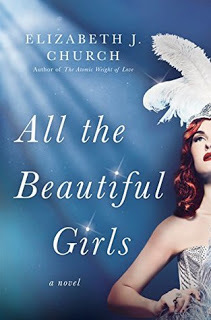
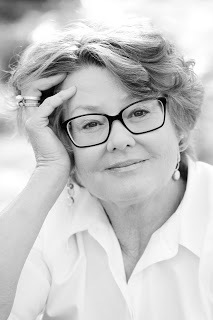
I first met Elizabeth Church at a book festival (This is why writers adore book festivals. We get to meet the authors we love.) In our case, we instantly bonded, and I love Elizabeth so much, I keep trying to convince her to move next door.
She's the author of THE ATOMIC WEIGHT OF LOVE was touted by the New York Times for its "elegant glimpse into the evolution of love and womanhood." Her new novel, ALL THE BEAUTIFUL GIRLS, about Las Vegas in its heyday, show girls, and the connections we make--and break--is even more glorious. Plus, it has feathers and sequins.
Big hugs and love to you, Elizabeth, for being here.
<!-- /* Font Definitions */ @font-face {font-family:"MS 明朝"; mso-font-charset:78; mso-generic-font-family:auto; mso-font-pitch:variable; mso-font-signature:-536870145 1791491579 18 0 131231 0;} @font-face {font-family:"Cambria Math"; panose-1:2 4 5 3 5 4 6 3 2 4; mso-font-charset:0; mso-generic-font-family:auto; mso-font-pitch:variable; mso-font-signature:-536870145 1107305727 0 0 415 0;} @font-face {font-family:Cambria; panose-1:2 4 5 3 5 4 6 3 2 4; mso-font-alt:Cambria; mso-font-charset:0; mso-generic-font-family:auto; mso-font-pitch:variable; mso-font-signature:-536870145 1073743103 0 0 415 0;} /* Style Definitions */ p.MsoNormal, li.MsoNormal, div.MsoNormal {mso-style-unhide:no; mso-style-qformat:yes; mso-style-parent:""; margin:0in; margin-bottom:.0001pt; mso-pagination:widow-orphan; font-size:12.0pt; font-family:Cambria; mso-ascii-font-family:Cambria; mso-ascii-theme-font:minor-latin; mso-fareast-font-family:"MS 明朝"; mso-fareast-theme-font:minor-fareast; mso-hansi-font-family:Cambria; mso-hansi-theme-font:minor-latin; mso-bidi-font-family:"Times New Roman"; mso-bidi-theme-font:minor-bidi;} .MsoChpDefault {mso-style-type:export-only; mso-default-props:yes; font-family:Cambria; mso-ascii-font-family:Cambria; mso-ascii-theme-font:minor-latin; mso-fareast-font-family:"MS 明朝"; mso-fareast-theme-font:minor-fareast; mso-hansi-font-family:Cambria; mso-hansi-theme-font:minor-latin; mso-bidi-font-family:"Times New Roman"; mso-bidi-theme-font:minor-bidi;} @page WordSection1 {size:8.5in 11.0in; margin:1.0in 1.25in 1.0in 1.25in; mso-header-margin:.5in; mso-footer-margin:.5in; mso-paper-source:0;} div.WordSection1 {page:WordSection1;} </style> --> <div class="MsoNormal"><b>Your novel The Atomic Weight of Love won so many awards and was a mega-seller. Was it at all nerve-wracking to set forth on a new novel? Or easier because of your huge success?</b></div><div class="MsoNormal"><br /></div><div class="MsoNormal">I actually began writing All the Beautiful Girls even before I had an agent or sold The Atomic Weight of Love to a publisher.<span style="mso-spacerun: yes;"> </span>What was nerve-wracking with this second novel was showing the manuscript of All the Beautiful Girls to my first reader, my agent.<span style="mso-spacerun: yes;"> </span>I was fearful that she’d have to figure out some diplomatic way of telling me that I was a one-hit wonder, and that I should find some other way to pay my living expenses.<span style="mso-spacerun: yes;"> </span>Since I’ve often sworn that I’d rather clean toilets for a living than return to practicing law, failure was not a happy prospect.<br /><br /><b>What instantly drew me into your fabulous novel was the story world, so alive with the glitter of Vegas, and the glittering personalities like Sammy Davis Jr., Tom Jones. That must have been really fun to research!<span style="mso-spacerun: yes;"> </span>So tell us about the research—what surprised you? What derailed your plot and sent it in another direction? </b></div><div class="MsoNormal"><br /></div><div class="MsoNormal">Research was a blast!<span style="mso-spacerun: yes;"> </span>I loved learning about the costumes, sixties fashion (including eye makeup especially), the stage sets, and of course those celebrity personalities.<span style="mso-spacerun: yes;"> </span>I read a number of books, but I also discovered some treasure-troves of images (showgirl photos, costumes, actual menus from Vegas venues), online.<span style="mso-spacerun: yes;"> </span>I will say that I ended up with a lot of bizarre pop-up ads, based on my internet searches.<span style="mso-spacerun: yes;"> </span>Predictably, there were ads for Vegas airfares and hotels, but I also received ads for G-strings, club wear, and yes – feather outlets.<span style="mso-spacerun: yes;"> </span></div><div class="MsoNormal"><br /></div><div class="MsoNormal">I didn’t plan to write about what was going on outside of Vegas (Vietnam, the Civil Rights Movement), but as time wore on, I couldn’t help but think of the contrast between that city of make-believe and the rest of the world, how strenuously many must have worked to keep hippies and protestors away from the Strip.<span style="mso-spacerun: yes;"> </span>I think that was the part of writing this novel that surprised me most – the insight I gained about growing tumult in American culture versus commercialism and peoples’ need to escape to places like Vegas.</div><div class="MsoNormal"><b><br /></b></div><div class="MsoNormal"><b>I’m curious about why you set it in the Golden Age, rather than now. How have things changed?</b></div><div class="MsoNormal"><br /></div><div class="MsoNormal">I wrote about the time when I would have wanted to be in Vegas, versus now.<span style="mso-spacerun: yes;"> </span>I actually was in Vegas in 1966, but I was a child – and so all I could do was walk the sidewalks, look up at the vast neon displays, and wonder what lay behind the doors and curtains.<span style="mso-spacerun: yes;"> </span>I see classic Vegas as the best time for that city in the desert.<span style="mso-spacerun: yes;"> </span>To me, it was a time of dignity and true class, and of acts that relied solely upon talent – not plastic showmanship – to entertain.<span style="mso-spacerun: yes;"> </span>Today’s Vegas, with its fake tidbits from Paris or Italy, its push to be a “family” vacation destination – it all rings untrue to me, and it seems a pallid, watered-down version of what once was.<span style="mso-spacerun: yes;"> </span>But, this is all from a woman who loves a good bar – dark ambience, cigarette smoke, highballs and Manhattans, cocktail dresses, men with ties, and even clip-on earrings.<span style="mso-spacerun: yes;"> </span>Maybe my age is showing….</div><div class="MsoNormal"><br /></div><div class="MsoNormal"><b>I don't want to give anything away, but what I thought was going to happen with her and the Aviator never did—and I actually found that tremendously satisfying. What were you thinking about when you created the Aviator?</b></div><div class="MsoNormal"><br /></div><div class="MsoNormal">I originally intended that the Aviator be present only for a few pages, as the man who killed Lily’s family.<span style="mso-spacerun: yes;"> </span>But the Aviator refused to go.<span style="mso-spacerun: yes;"> </span>He became – quickly and initially without my permission – an overarching figure.<span style="mso-spacerun: yes;"> </span>And so, I let him stay – and as I wrote, his role became clear.<span style="mso-spacerun: yes;"> </span>Truthfully, I’m more than a little in love with the Aviator, with what he comes to represent, the genuine, abiding, unshakable love he has for Lily.<span style="mso-spacerun: yes;"> </span>In the end, he became a way for me to achieve many goals, among which was to pay homage to a man I dearly loved in “real” life.</div><div class="MsoNormal"><b><br /></b></div><div class="MsoNormal"><b>So much of All the Beautiful Girls is about power and having control over our lives, despite former trauma. Even the word “Girls” in the title indicates that, and there is that haunting half photo of Ruby on the cover. I know how often covers and titles change, so can you talk about the process for </b>us?</div><div class="MsoNormal"><br /></div><div class="MsoNormal">I had two original titles for the book.<span style="mso-spacerun: yes;"> </span>My working title was “The Tender Places,” which was then replaced by “Map of Venus.”<span style="mso-spacerun: yes;"> </span>I think “All the Beautiful Girls” says more than my original titles, though, because it speaks to the beauty in ALL of us, and in particular to the beauty we all have despite our wounds.<span style="mso-spacerun: yes;"> </span>In terms of the cover, I absolutely adore this cover – it shows not only the limelight, the diamonds, and the glamor of what I try to depict in the novel, but also is enormously feminine.<span style="mso-spacerun: yes;"> </span>I also quite relish the vivid blue color.<span style="mso-spacerun: yes;"> </span>There is another version of the cover created by my publisher in the United Kingdom.<span style="mso-spacerun: yes;"> </span>I love that cover, too – which shows a crowd of showgirls gathered backstage and features the perfect sixties font (I call it the “Jacqueline Susann font”).<span style="mso-spacerun: yes;"> </span>Both cover images capture not only the beauty of female dancers, but also the accentuation of that beauty through stage makeup and all those elegant feathers.</div><div class="MsoNormal"><br /></div><div class="MsoNormal"><b>I loved the line about having a future, except it doesn’t look like what you thought it might. Can you talk about this please?</b></div><div class="MsoNormal"><br /></div><div class="MsoNormal">I have to say that this is one of my favorite aspects of life:<span style="mso-spacerun: yes;"> </span>the unpredictability, the humbling that occurs when I’m proven wholly wrong in my predictions and expectations about what my life will be.<span style="mso-spacerun: yes;"> </span></div><div class="MsoNormal"><br /></div><div class="MsoNormal">In my writing, I like to strip away all of my characters’ expectations, their best-made plans.<span style="mso-spacerun: yes;"> </span>I set out to strip them of comfort and happy endings, because that is how I think life works.<span style="mso-spacerun: yes;"> </span>What is interesting, to me, is how a person reacts to pain, to heartache – how she chooses to be in the wake of loss and disappointment.<span style="mso-spacerun: yes;"> </span>I respect resiliency, and I think we’re all capable of it, if we require more of ourselves.<span style="mso-spacerun: yes;"> </span>Besides, isn’t life our greatest creative project?<span style="mso-spacerun: yes;"> </span>What matters is what we create for ourselves, each and every day, despite every hurdle that we might encounter.<span style="mso-spacerun: yes;"> </span></div><div class="MsoNormal"><br /></div><div class="MsoNormal"><b>What’s obsessing you now and why?</b></div><div class="MsoNormal"><br /></div><div class="MsoNormal">Grief, family dynamics.<span style="mso-spacerun: yes;"> </span>The often vastly different experiences of siblings within the same family, with the same parents.<span style="mso-spacerun: yes;"> </span>Whether siblings can ever come to terms with their different upbringings, their competitions and jealousies, and whether ultimately there can be acceptance of each individual for who she is.<span style="mso-spacerun: yes;"> </span>These are some of the themes I’m working on in my third novel.<i style="mso-bidi-font-style: normal;"><br /><br style="mso-special-character: line-break;" /><b><br style="mso-special-character: line-break;" /></b></i></div><div class="MsoNormal" style="margin-bottom: 12.0pt;"><b>I was fascinated by the palmistry. How did you learn so much about it? Do you read palms? Did you have yours read?</b></div><div class="MsoNormal" style="margin-bottom: 12.0pt;">In college, I became fascinated by palm reading and tarot cards.<span style="mso-spacerun: yes;"> </span>Rather ghoulishly, the scientist in me wanted to see the palms of recently deceased persons so that I could check their lifelines, learn whether those lines were accurate in their prediction of life expectancy.<span style="mso-spacerun: yes;"> </span>I studied books on palmistry (and had to refresh my memory for purposes of writing Lily/Ruby’s story), and I had a few friends who knew some palmistry (one friend had an aunt who claimed to be psychic).<span style="mso-spacerun: yes;"> </span>I’ve found that if word gets out at a party, I will have a line of people asking that I read their palms.<span style="mso-spacerun: yes;"> </span>Do I believe in it?<span style="mso-spacerun: yes;"> </span>Yes – but only in that it is yet another system by which we can try to understand our lives, the choices we’ve made.<span style="mso-spacerun: yes;"> </span></div><div class="MsoNormal" style="margin-bottom: 12.0pt;">I once had my palm “professionally” read.<span style="mso-spacerun: yes;"> </span>I was told that I had a very sparkly aura, that I was highly psychic, and that I would be reading palms within two years of that reading.<span style="mso-spacerun: yes;"> </span>I think I prefer writing fiction – although some might argue that the two are not that far apart.</div><div class="MsoNormal"><b>What question didn’t I ask that I should have?</b></div><div class="MsoNormal"><br /></div><div class="MsoNormal">You’ve not asked me about something I know you understand, Caroline – and that is the mind-boggling thrill of learning that what I’ve created in the solitude of my home, what’s arisen in my mind when I walk or swim, has somehow resonated with a reader.<span style="mso-spacerun: yes;"> </span>How breathtaking it is to discover that what I’ve written has touched another life, that my characters’ struggles have found a place in the thoughts of another.<span style="mso-spacerun: yes;"> </span>I cannot imagine a greater miracle – or any more striking evidence of the power of the written word.</div><div class="MsoNormal"><br /></div><div class="MsoNormal"><br /></div>
Published on March 06, 2018 09:34
February 19, 2018
What would happen if all birth control were made illegal and parents had to be licensed? Kristen Tsetsi talks about that and her profound new novel THE AGE OF THE CHILD.
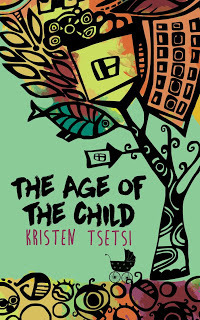
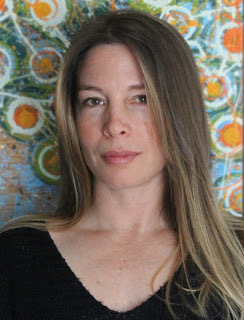
I first met novelist Kristen Tsetsi because of a hilarious video she and writer R. J. Keller made about writing from Inside the Writer Studio/Paper Rats. Of course I wanted to be in one, so I stalked them both, got to do one, and a friendship was born.
Kristin's newest novel, THE AGE OF THE CHILD, is a provocative look at reproductive rights in our culture. And it's already racking up raves:
"A masterstroke in the dystopian revival, The Age of the Child is visionary, relevant, and unnervingly plausible." Brian Felsen, founder of BookBaby
"When we are through [reading The Age of the Child], we are thinking hard about things we’ve heard many say and things we’ve thought or said ourselves about children or parenting. We’re tempted into a conversation that we’ve not had with spouses, friends, or acquaintances." Elizabeth Marro, author of Casualties
"Tsetsi tells a story that will keep you reading and wondering late into the night." James C. Moore, MSNBC political commentator and co-author of the NYT best-selling Bush's Brain: How Karl Rove Made George W. Bush Presidential
"An intriguing look at a future that feels frighteningly possible." Journal Inquirer
"Smart writing, interesting characters, and just a good story. Tsetsi gives the readers food for thought." Carol Hoenig, co-owner, Turn of the Corkscrew Books & Wine
Thank you so much for being here, Kristen!
What was haunting you when you wrote this book?
Oh, so many things... Pharmacists using religion as a reason to deny women hormonal birth control. Rick Santorum's concerns over "the dangers of contraception." People who would argue that, say, a forcibly impregnated teenager (that's the most sanitary way I can say it) should be denied the option of abortion. The politician (I don't care to look up his name, because I don't care to know it) who suggested that women who don't want to get pregnant should put an aspirin between their knees.
But also, the lack of any conversation or any real, meaningful action that spoke to a genuine concern for the quality of life of these potential humans the pro-life movement professes to care so deeply about.
It's such a wild contradiction (and so bafflingly - is that a word? - hypocritical) that it was driving me mad. Any time I heard, "Think of the children," I thought, "Yes. Could we, possibly?"
The Age of the Child thinks of the children in two different reproductive rights restrictions scenarios, both carried out under a Citizen Amendment, which the administration had, by the novel's opening, recently ratified to protect every potential citizen's right to life. The first scenario: all birth control is banned and abortion is criminalized (even miscarriages are treated as suspect); the second: as a reaction to the consequences of the birth control ban, parent licensing has been enacted and anyone hoping to be a guardian (whether adoptive or biological) must first submit to an evaluation.
Parent licensing was the initial idea for the story, but I realized before finally sitting down to start that it would be impossible to write about licensing without also writing about how we got there.
What was it like writing this novel? Did you find it different than writing your other novels, and if so, in what way?
I was more anxious about this one. The subject matter is tricky, and I wanted to do it justice without getting Ayn Rand-preachy from any angle. It was also important to not write heavy when the subject matter was already pretty heavy.
What this means (this might sound terrible) is that I got to have a lot of fun with some otherwise brutal conversations and relationship situations. As you can imagine, a relationship will be tested in a no-birth control environment when a woman who doesn't want to have children avoids having traditional intercourse with her husband. (Amazingly, the real-life male politicians endorsing blocks to birth control and abortion fail to connect those actions with the likelihood that they may be threatening their own sex lives...)
When writing The Age of the Child, I went into it with a deep appreciation for Joseph Heller's Catch-22 and Aldous Huxley's Brave New World, both of which incorporate humor and/or the absurd to make a devastatingly serious point. My other novels are a little more straightforward.
Did you always know your ending, or did it take you by surprise?
It came as a complete and thrilling surprise.
I'd written one ending and was positive that was it. "Good!" I thought. "Done!" But after going through the draft again and reaching the last page, I thought it was unsatisfying, somehow.
It's hard to remember when the right ending came to me - maybe while walking my dog, Lenny (who has a character named after her), or maybe it was while trying really hard to listen to something my husband, Ian, was saying (I don't mean to do it, I really don't, and I swear he isn't at all boring, but when you're working on a plot problem, there's really no point in trying to control concentration, is there? It doesn't work! Ian understands).
All I know for certain is that the original ending was making my center roil in an unsettling feeling of "meh" until I was hit by what should happen. It was the only thing that made sense. It was perfectly inevitable! It was one of those relief/excitement moments that make you want to shake somebody.
What was the why now moment of writing this novel?
First, it (reproductive rights vs a child's right to quality of life) was important to me as an issue. When something is important, I think it should be addressed as immediately as possible. I don't even think the subject matter I cover is timely as much as it's our history, our present, and likely our future (by "our" I mean globally). But it had all been bothering me so obsessively, and I'd been having so many real or imagined arguments about it, that it was time.
Second, how to address the issue(s) in a novel had finally been ruminated over long enough for the ideas and characters to have built into something I could finally start with enough confidence to believe I could move from one page to at least one more.
What’s obsessing you now and why?
Trying to stay positive, because Trump.
What question didn't I ask that I should have?
The only thing I can think of, and this is only because I'm excited to share it, is that I'll be doing a book signing at the Manchester Public Library in Manchester, CT on Monday, March 12 at 7 p.m., and I'll be a guest on the Colin McEnroe Show (Connecticut Public Broadcasting/WNPR) on Wednesday, March 21, 1-2 p.m.. Listen live or stream online!
Published on February 19, 2018 08:52
February 7, 2018
Yes, women did work on the atom bomb, and Janet Beard's novel ATOMIC CITY GIRLS is a stunning exploration of what that was like.
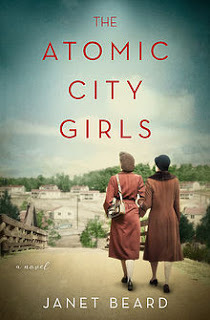

<!-- /* Font Definitions */ @font-face {font-family:"MS 明朝"; mso-font-charset:78; mso-generic-font-family:auto; mso-font-pitch:variable; mso-font-signature:-536870145 1791491579 18 0 131231 0;} @font-face {font-family:"Cambria Math"; panose-1:2 4 5 3 5 4 6 3 2 4; mso-font-charset:0; mso-generic-font-family:auto; mso-font-pitch:variable; mso-font-signature:-536870145 1107305727 0 0 415 0;} @font-face {font-family:Cambria; panose-1:2 4 5 3 5 4 6 3 2 4; mso-font-alt:Cambria; mso-font-charset:0; mso-generic-font-family:auto; mso-font-pitch:variable; mso-font-signature:-536870145 1073743103 0 0 415 0;} /* Style Definitions */ p.MsoNormal, li.MsoNormal, div.MsoNormal {mso-style-unhide:no; mso-style-qformat:yes; mso-style-parent:""; margin:0in; margin-bottom:.0001pt; mso-pagination:widow-orphan; font-size:12.0pt; font-family:Cambria; mso-ascii-font-family:Cambria; mso-ascii-theme-font:minor-latin; mso-fareast-font-family:"MS 明朝"; mso-fareast-theme-font:minor-fareast; mso-hansi-font-family:Cambria; mso-hansi-theme-font:minor-latin; mso-bidi-font-family:"Times New Roman"; mso-bidi-theme-font:minor-bidi;} .MsoChpDefault {mso-style-type:export-only; mso-default-props:yes; font-family:Cambria; mso-ascii-font-family:Cambria; mso-ascii-theme-font:minor-latin; mso-fareast-font-family:"MS 明朝"; mso-fareast-theme-font:minor-fareast; mso-hansi-font-family:Cambria; mso-hansi-theme-font:minor-latin; mso-bidi-font-family:"Times New Roman"; mso-bidi-theme-font:minor-bidi;} @page WordSection1 {size:8.5in 11.0in; margin:1.0in 1.25in 1.0in 1.25in; mso-header-margin:.5in; mso-footer-margin:.5in; mso-paper-source:0;} div.WordSection1 {page:WordSection1;} </style> <br /><div class="MsoNormal"><br /><br /><i><a href="http://www.janetbeard.com/">J... Beard</a> is also the author of BENEATH THE PINES, as well as her latest, THE ATOMIC CITY GIRLS, which is a stunning novel about the women who worked on the bomb. And she's racking up the raves. Take a look:</i></div><h4 class="font_4" style="font-size: 19px; line-height: 1.8em; text-align: justify;"><i><span style="font-weight: normal;"><span style="font-family: "times" , "times new roman" , serif;"><span class="color_11"><span style="font-size: 19px; letter-spacing: 0.1em;">"</span></span><span class="color_11"><span style="font-size: 19px; letter-spacing: 0.1em;">Beard has taken a project of momentous impact and injected a human element into it... This is approachable</span></span><span class="color_11"><span style="font-size: 19px; letter-spacing: 0.1em;">, intelligent, and </span></span><span class="color_11"><span style="font-size: 19px; letter-spacing: 0.0633333em;">highly</span></span><span class="color_11"><span style="font-size: 19px; letter-spacing: 0.1em;"> satisfying historical fiction."- </span></span><span class="color_11"><span style="font-size: 19px; letter-spacing: 0.1em;">Booklist *</span></span><span class="color_11"><span style="font-size: 19px; letter-spacing: 0.1em;">starred review</span></span></span></span></i></h4><div class="MsoNormal"><i>Thank you so much for being here, Janet!</i><b><br /><br />What was haunting you when you wrote this book?</b></div><div class="MsoNormal"><br /></div><div class="MsoNormal">I’ve been haunted by the idea of the atomic bomb since I first learned about it as a child at the science museum in Oak Ridge near where I grew up. The challenge in writing the book was trying to imagine how the knowledge that they were helping to create these terrifying weapons would affect my characters, without imposing on them my twenty-first century knowledge and anxieties. They have their own knowledge and anxieties within the context of World War II. </div><div class="MsoNormal"><br /></div><div class="MsoNormal">Unfortunately, the threat of nuclear weapons has only grown more intense since I began the book, and I’m more haunted than ever in our current political moment.</div><div class="MsoNormal"><br /></div><div class="MsoNormal"><br /></div><div class="MsoNormal"><b>What surprised you the most about your research?</b></div><div class="MsoNormal"><br /></div><div class="MsoNormal">One surprising takeaway from reading the many interviews and oral histories of young people who came to work in Oak Ridge, was how fondly they remembered their time there. Despite the anxiety of wartime and hardship of living in a military reservation, they had a lot of fun. For many, it was the first time they had left home, and they were living with hundreds of other young people, working hard but also playing hard in their free time at dances, roller rinks, and bowling alleys. </div><div class="MsoNormal"><br /></div><div class="MsoNormal"><br /></div><div class="MsoNormal"><b>What kind of writer are you? Do you have rituals, do you outline, or do you simply let the story tell itself (ha ha ha.)</b></div><div class="MsoNormal"><br /></div><div class="MsoNormal">I am a big planner and compulsive list maker in all aspects of my life, especially writing. I love research, even when I’m not writing historical fiction, which obviously requires it. And outlining is essential for me. I don’t really have any rituals, but I do try to force myself to write first thing every day that I can—before all the other items on my to do list take over my brain. </div><div class="MsoNormal"><br /></div><div class="MsoNormal"><br /></div><div class="MsoNormal"><b>It’s fascinating that women were involved in making a bomb—we always tend to think of women as more reasonable when it comes to war. Can you talk about this please?</b></div><div class="MsoNormal"><br /></div><div class="MsoNormal">World War II affected all Americans, and people had a deep sense of patriotic and moral duty that can be hard to understand from a cynical twenty-first perspective. Most Americans were willing to do what the government asked of them, whether it was enlisting in the Army, collecting cooking oil, or working in wartime factories. The general sense was that the United States hadn’t asked to be part of the war, but when forced to become involved, America would do everything possible to defeat its enemies. That attitude extended to both genders, and the overwhelming reaction of women looking back on their work on the Manhattan Project was pride that they had helped end the war. Again, it can be hard for us to understand now, but the horror of unleashing atomic weapons on the world was not foremost on their minds at the time. Rather, they felt joy and relief that their brothers and husbands would be coming home. </div><div class="MsoNormal"><br /></div><div class="MsoNormal"><br /></div><b> </b><br /><div class="MsoNormal"><b>What’s obsessing you now and why?</b><br /><br style="mso-special-character: line-break;" /></div><div class="MsoNormal">Murder ballads. I’m working on a new novel about six generations of women in Appalachia, inspired by the old ballads that typically tell the story of a man murdering a young woman. I’m obsessed with why we are all so obsessed with telling stories about violence against women. </div><div class="MsoNormal"><br /></div><div class="MsoNormal"><br /><b>What question didn’t I ask that I should have?</b></div><div class="MsoNormal"><br /></div><div class="MsoNormal">This is the hardest question of all! Probably the most important element of the novel for me is the characters. As important as getting the history right was to me, it’s meaningless without strong characters to craft a story around. Once they came alive in my mind, it was simply a matter of getting their stories on the page. </div><br /><span class="notification_message"></span>
Published on February 07, 2018 10:37
Buffalo Bill. Sitting Bull. And Annie Oakley! Deanne Stillman talks about the extraordinary relationship between the three and her book BLOOD BROTHERS.
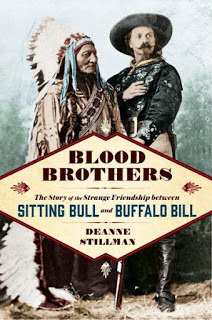
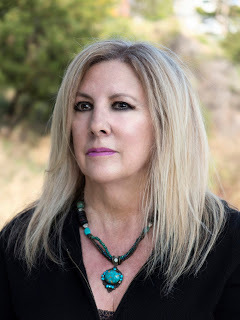
I love history, which means I worship the books of Deanne. Her latest, BLOOD BROTHERS, is about the incredible relationship between Sitting Bull and Buffalo Bill--and yes, Annie Oakley, as well.
Deanne Stillman is the author of Desert Reckoning: A Town Sheriff, a Mojave Hermit, and the Biggest Manhunt in Modern California History, Mustang: The Saga of the Wild Horse in the American West, Twentynine Palms: A True Story of Murder.
Thank you so much for being here, Deanne!
What was haunting you when you wrote this book?
When Sitting Bull went home to Standing Rock after traveling with Buffalo Bill in the Wild West show for four months in 1885, Cody gave him a horse. Five years later when Sitting Bull was assassinated, the horse was outside his cabin and “danced” as the bullets were flying. This was because it had been trained to perform at the sound of gunfire in Cody’s show. Sitting Bull was killed at the height of the Ghost Dance frenzy – the apocalyptic movement which swept through the tribes of the Great Plains when their empire was fading. It began with a prophet – or a con man, take your pick – named Wovoka, a Paitue Indian in Nevada. If you danced with great intent, he said, the buffalo would return and the time before the white man would be reinstated. Some of Sitting Bull’s people made a pilgrimage to Nevada and met with Wovoka, returning with his teachings. Many Lakota started to dance – to the dismay of army officials.
It was one more thing Sitting Bull was “blamed” for, in addition to killing Custer at the Battle of the Little Bighorn. But he didn’t kill Custer and nor did he incite the dancing. Nevertheless, it was time for him to go, and newspapers picked up the call. Tribal police were enlisted to make his arrest, which led to his killing, and there was this horse – a Ghost Horse as I imagined it – joining in as Sitting Bull walked on, to use the Native American term for death. Or so went the legend. That image haunted me for years, and I had to go inside it and find out what forces led to that moment in which a horse from Buffalo Bill was outside Sitting Bull’s cabin responding to his passing – and the end of an era. I knew that some day, it would become a book, and that’s where Blood Brothers comes from. Why do you think the story of the friendship between Sitting Bull and Buffalo Bill isn’t so widely known? Does it take away from Wild West mythology?
I think a lot of things about the frontier era, specifically many important elements of the Indian wars, both before and after the Civil War, aren’t widely known. But that only adds to the myth. The Wild West is mysterious and alluring and exciting, but behind that is another story.
I would say that mainly, a lot of people are aware of “Custer’s Last Stand.” America lives inside that famous moment of defiance, whether or not it actually happened the way that it’s often conveyed. Think about all of the jokes about Waco when that went down, at least in certain quarters. “We ain’t comin’ out” is what people said it stood for, and we heard it in the recent TV series about that incident. It’s a rebel yell, it’s what drove the invasion of Malheur. The spirit of “go fuck yourselves” is really a primary component of our DNA. When Custer was killed, someone had to be blamed, and that was Sitting Bull, already a notorious figure. Although he didn’t pull the trigger, he was nearby. As I write in my book, his medicine was all over the battlefield.
After the Bighorn, he became Public Enemy One, and when he returned from exile in Canada a few years later, everyone wanted him for their road shows. He ultimately signed on with fellow superstar Buffalo Bill, a fated alliance in my view, two sides of the buffalo coin. They were interviewed together from time to time as they criss-crossed the country, and praised each other in front of each other to reporters – a show business moment which we have no equivalent of today - and of course Cody was very much a man of his own mythology. But what went on between them was not tracked for the most part; people weren’t watched and scrutinized like they are now, and certainly men were not “sharing” their feelings in public announcements. The main thing was the symbolism of their alliance, as publicity for the show said: “foes in 76 and friends in 85” and the fact that these two former enemies crossed a bridge under the banner of show business and inside of that, other things happened. Again, I get back to the dancing horse. The moment outside Sitting Bull’s cabin speaks volumes.
In my book, I explore lesser known aspects of their time together, and speculate about some of that. They were two larger than life figures with much in common – fathers, sons, influential, charismatic, revered among their own people yet trapped in a bloody history and personas which threw them together. Appearing as co-stars served to compound their fame, and heighten mythology of the Wild West - which Cody was presenting in his show, from the white man’s point of view. I call it the national scripture; Cody and his cast were re-creating episodes of Manifest Destiny moments after they had happened, using some of the actual players.
And this was happening as the frontier was closing, a strange portrayal of a world that was on its way out. The Indians in the Wild West were essentially prisoners of war, joining the show as a way off the reservation. As for cowboys, although the show was an equestrian extravaganza, the age of the horse was nearly over and outside of the show, they were out of a job. At Cody’s funeral in Denver in 1917, America had its first traffic jam. That’s how many people came to mourn him – and it says a lot about the end of an era. But that’s the era that lives forever in the American heart, for better and for worse.
What surprised you the most about your research?
A most surprising thing was how critical Annie Oakley was to the coming together of Cody and Sitting Bull. In fact, Sitting Bull may not have joined the Wild West had it not been for Annie. Shortly before signing with Cody, he was in St. Paul, Minnesota with a reservation official, touring the area to meet local dignitaries and familiarize himself with aspects of the civilization which were displacing the Lakota. Annie Oakley and her husband Frank Butler, also a marksman, were giving a shooting exhibition, and Sitting Bull evidently was quite taken with Annie’s skills. After the show, he sent her a note “backstage,” or to her hotel room, kind of a fan note apparently, and said he’d like to meet her. So they met and became fast friends, and soon he gave her the nickname of “Little Miss Sure Shot,” although that was a mistranslation.
I can’t give away the real meaning here, but the main thing is that here was Sitting Bull essentially branding Annie Oakley, to use today’s parlance. I’ve often wondered if she would have attained the same level of fame without that nickname, and in any case, she joined up with Cody shortly before Sitting Bull did, and when Cody was trying to convince Sitting Bull to come aboard, one of the things that made him feel more comfortable in doing so was the presence of Annie Oakley. He seems to have regarded her as a surrogate daughter. Cody himself was quite taken with her, in love with her I would say, yet their affair was not physical - unlike his numerous others over the years, although he was married.
And so you could say that a woman runs through the story of Sitting Bull and Buffalo Bill, and that woman was Annie Oakley.
I love that Annie Oakley is a character. What misconceptions do you think people have about her?
People don’t realize that she was a voracious hunter and that she supported her family from the time she was a little girl and until she became a traveling sharpshooter by way of her knowledge of the woods. Her family was poor, like many on the frontier, and she provided them with supper that she herself had killed. At some point, she began selling game to restaurants in Cincinnati, and making quite a good living. In fact, she was killing so many animals that she was told to put a lid on it. For that era, when there were few regulations about anything, especially something like hunting, that was a big deal.
Of late, there’s been a retelling of what the old West was like. I saw and loved Hostiles, a nuanced film about what we did to the American Indians—and how they fought back. Can you talk about the Old West here, please?
Yes, it’s a very good film, and it has some parallels to the story I tell in Blood Brothers. Of course the term “hostiles” refers to Indians who refused to turn themselves into reservations as the frontier wars were winding down. Sitting Bull, Crazy Horse and a number of others were such figures. After Crazy Horse was killed following his surrender and betrayal, Sitting Bull and some Lakota who travelled with him into the protection of the “Grandmother”- or Canada – were the last “hostiles” to return to their lands south of the Medicine Line, meaning the Dakota Territory.
I recount the return of Sitting Bull and his people in my book, and it’s some of the most difficult material I’ve written. You would think there would have been a lot of fanfare marking the return of this great figure, especially since many army officials viewed Sitting Bull as a premiere military tactician, a general for all time. Really, there was none – among white folk, that is. But others of his tribe who had already surrendered lined the riverbanks as the steamer carrying him arrived. Later, in a ceremony at Fort Buford, he instructed his young son to surrender his rifle. I’ve wondered what the soldiers who were in attendance were thinking. They were witnessing one of history’s great and most tragic reversals of fortune. Not surprisingly, soon after Sitting Bull had laid down his arms, his captors sought his autograph, his company, his medicine – everyone wanted a piece of him, and he loaned himself to Buffalo Bill for a brief time. According to a newspaper account of the first time that the two men met, amid a show in Buffalo, of all places, Cody actually seemed to shrink in stature as Sitting Bull approached. It was a fleeting moment – but that’s how cataclysmic it was.
As the movie ads say, “We are all hostiles,” and as I mentioned, the coming together of Buffalo Bill and Sitting Bull was billed as “Foes in 76 and friends in 85.” Who better to make peace than former enemies? We saw this happen at Standing Rock during the protests over a year ago. Army veterans, themselves descendants of soldiers who had fought at the Little Bighorn, apologized to Lakota elders in a ceremony that was not widely covered, acknowledging the American betrayal of the Indian nations on the plains. To me, this marked a spiritual shift that is now underway, and it was a profound and necessary moment. I try to stay focused on that as the country seems to be coming apart at the seams.
What’s obsessing you now and why?
The government assault on land, sea, and air, and on wildlife. It’s not new, but it’s a ratcheting up of this American schizophrenia that we have, this worship of freedom and simultaneous urge to wall it up and destroy it. What’s going on now is the end game of the Indian wars, and now is the time to continue what began at Standing Rock in 2016 and what red and white men tried to do in their own ways long before that, even in that strange piece of living theatre called the Wild West show.
What question didn’t I ask that I should have?
I think you’ve covered it. Thank you!
Published on February 07, 2018 10:04
January 25, 2018
Want to be part of a funny, moving, smart, diverse new TV series? Writer/director/executive producer Debra Markowitz talks about COUPLE OF GUYS, fundraising, celebrities and more
 Couple of Guys is about two men in love
Couple of Guys is about two men in love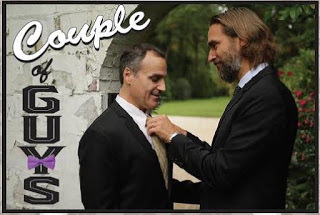 Yep, it's amazing
Yep, it's amazing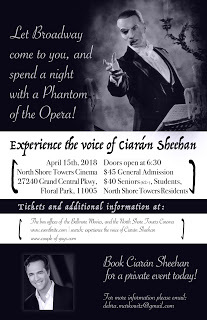 This is for a fundraiser that will actually BE fun
This is for a fundraiser that will actually BE fun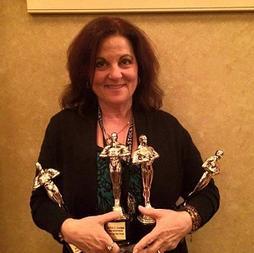 Portrait of the genius behind all of this
Portrait of the genius behind all of thisFirst, before we do anything, you have GOT to watch the promo for COUPLE OF GUYS.
I feel like I've always been friends with writer/director/executive producer Debra Markowitz. (She's that kind of person.) She's amazing. She has been the Nassau County Film Commissioner through three administrations, Debra also was a founder and programmer for LIIFE, the Long Island International Film Expo, for the past 19 years. She is an award-winning director and producer for her films The Last Taxi Driver and Leaving. Her third film, By Blood, is just entering the festival circuit now. Debra has also cast and produced films for other directors. She is the author of the Karmic Wind Trilogy (Naked in the Rain, Sarah and Caleb, and Karmic Wind). Her new project COUPLE OF GUYS is funny, moving, diverse and yes, important, and I'm so honored that she's here to talk about it.
Thank you, Debra!
Couple of Guys is a brilliant story, about two perfectly married gay men and what happens when one of them begins to yearn for a kid—and the other’s ex-wife, who has older kids by him, begins to interfere. Tell us what it was about this story that made you feel you had to make the series?
The more I thought about the story of Richard and Jon, the more I started fantasizing about what their lives would be like. Starting with the pilot, when Richard (previously married divorce attorney with two grown children) and Jon (former rocker who has lived the wild and crazy life) meet in a record store, and Richard takes a chance and asks Jon for coffee- they’re looking for what we all want: true love. Is he gay too, would he be interested, why me? I fell in love with the characters as much as they fall in love with each other. I wanted to know what their lives would be like through the good, and the bad. How would they handle it, and how would the people in their lives evolve as time went on? This is perfect material for a series, but I wouldn’t be averse to turning it into a feature either, but their story has to be told.
Tell us more about the April 15th concert for fundraising. And how can people donate and support this?
I’m very excited about this! We have a diverse group of characters in Couple of Guys, and one of our supporting cast members is former Phantom of the Opera, Ciarán Sheehan, who plays Aiden McGlynn, hard-partying, lead singer of Jon’s band who refuses to grow up and longs to get back on the road. Such a contrast to the elegant Mr. Sheehan whose voice is impeccable and inspiring (some say healing) who has appeared in Phantom and Les Mis and so many other plays and concerts. We’ve had a few fundraisers for Couple of Guys, and when Ciarán sings, everyone freezes and there are more than a few tears shed.
There are a few ways to donate, the perks are on the page (and there are all levels of donation!). From a Thank you in credits, being an extra in the film/pilot, dedicating the film to a loved one, becoming a producer on the movie, even being a director for three takes of one scene! The perks can be found here. OR come to the fundraising concert and enjoy an evening of exquisite music (or both!). Tickets can be purchased here. And if you want to know more about Ciarán, you can go to his page.
What’s amazing to me is that this film is racking up raves and awards and it hasn’t even been made yet. That doesn’t happen often, does it? What do you attribute this to?
I’ve been very lucky to win some scriptwriting competitions with the pilot script. It’s very sweet, and romantic, and a little sexy, and I believe that people can feel the characters. Plus, who doesn’t like second chances and the possibility of finding true love?
You yourself are an incredible powerhouse. You wrote, directed and produced this series—and what I love about it is that it’s not only a diverse comedy, but it truly makes your emotions rise to the surface, something that doesn’t always happen. You “create films with a message”—but rather than being didactic, your films seem to operate on a much deeper level. Can you talk about this, please?
Every film I’ve done has a purpose, a secret message if you will. Whether it’s a silly film like The Last Taxi Driver. Dorman is a hero because as ridiculous as it might seem, to have a taxi driver who refuses to give up his cab when most of the inhabitants left on earth are zombies, well, he’s a hero! When all else is lost, he’s not giving up.
Leaving was a spiritual film that came from a dream I had. What if you left your family, but you always kept one foot in the door, not wanting to let go? No one can heal. It’s a difficult decision that Emily has to make. Tears abound in the audience when this film screens. By Blood is about mistaking ego for love, and the consequences that can have.
The Waiting Room brings in comedy and drama. When a woman waits in heaven for her husband to show up, she’s surprised when he arrives with his second wife. This movie is still on the festival circuit now, while The Last Taxi Drive, By Blood and Leaving are all screening on DirecTV, as well as Vimeo on Demand.
I have to say that the page about the film was so fascinating that I spent a half hour just clicking on all the links. I loved knowing what goes into making a pilot, and why it might be expensive; loved hearing how one of your stars wanted to be a rock star first, and of course the wonderful and funny perks, which I assume you named? Talk about this, too!
Thank you! Yes, I named the perks. There are a lot of crowd funding projects out there, but every project I’ve worked on has been made, and has done well on the festival circuit. You have to appeal to the audience’s desire to be responsible for the content they want to see. And they can help determine that by helping these projects come to life. So much of what is seen in mainstream media are formula films and series. Independent films can bring you something much different. Something you can be a part of, and be proud to be a part of.
What question didn’t I ask that I should have?
How did you get all these celebrities for this project?
Besides directing and writing, I also cast and produce for others as well as myself. I LOVE finding incredible talent. Our Couple of Guys, Sal Rendino (The Get Down, Gotti, Billions, The Americans) and Lukas Hassel (Limitless, Blacklist, Royal Pains and is also huge on the indie film circuit) are a director’s dream to work with. They are completely into this project, and the chemistry between them is amazing. It’s hard to get name actors before you have all your funding, but I’ve worked with most of these actors before, so they’ll jump on board and hopefully be available when filming begins. Our stars include Ryan’s Hope’s, Ilene Kristen, Broadway star Ciarán Sheehan (who will be in a slate of films this coming year, playing Sean Young’s boss in BIRR, and Joan Jett’s husband in Dinosaur), Deborah Twiss from Kick-Ass and Blue Bloods, and when this series takes off, we’ll have a number of other names that we’re pretty excited about. 30 Rock’s, Kevin Brown, Blue Bloods’ Robert Clohessy and Abigail Hawke, Clerks’ Brian O’Halloran and so many more!
Couple of Guys is a love story at its core, and I love these characters, and everyone else will too! Please help a gal out and come to this beautiful concert or donate so we can get this rolling, and please, check out the perks, we have some great ones!! You can find out more about me, my films, books and company here.
Thank you!
PLEASE LIKE AND FOLLOW
Facebook page
Published on January 25, 2018 13:02
January 19, 2018
Douglas Trevor talks about "the wild and messy world of the novel," his brilliant THE BOOK OF WONDERS, Proust, politics, and so much more
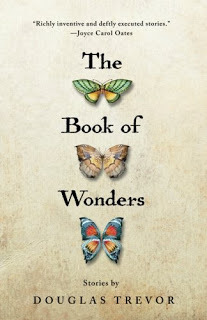
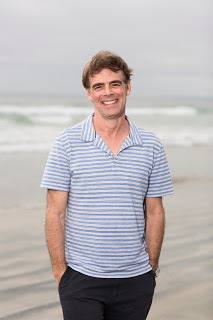
Doug Trevor is one of my favorite writers (And I'm not the only one singing his praises. You noticed the Joyce Carol Oates quote on the front of his book, right?) I haven't had the luck to meet him yet, but he lives in one of my favorite places, Ann Arbor, Michigan, where I was once a bookseller, so that makes me want to meet him even more. Reading his collection THE BOOK OF WONDERS makes my admiration for his work even greater.
Douglas Trevor is the author of the novel Girls I Know), and the short story collection The Thin Tear in the Fabric of Space. Thin Tear won the 2005 Iowa Short Fiction Award and was a finalist for the 2006 Hemingway Foundation/PEN Award for First Fiction. Girls I Know won the 2013 Balcones Fiction Prize. Doug’s short fiction has appeared most recently as a Ploughshares Solo, and in The Iowa Review, New Letters, and the Michigan Quarterly Review. He has also had stories in The Paris Review, Glimmer Train, Epoch, Black Warrior Review, The New England Review, and about a dozen other literary magazines. Doug lives in Ann Arbor, where he is the current Director of the Helen Zell Writers’ Program, and a Professor of Renaissance Literature in the English Department at the University of Michigan.
Thank you so much for being here, Doug!
<!-- /* Font Definitions */ @font-face {font-family:"MS 明朝"; mso-font-charset:78; mso-generic-font-family:auto; mso-font-pitch:variable; mso-font-signature:1 134676480 16 0 131072 0;} @font-face {font-family:"Cambria Math"; panose-1:2 4 5 3 5 4 6 3 2 4; mso-font-charset:0; mso-generic-font-family:auto; mso-font-pitch:variable; mso-font-signature:-536870145 1107305727 0 0 415 0;} @font-face {font-family:Cambria; panose-1:2 4 5 3 5 4 6 3 2 4; mso-font-charset:0; mso-generic-font-family:auto; mso-font-pitch:variable; mso-font-signature:-536870145 1073743103 0 0 415 0;} /* Style Definitions */ p.MsoNormal, li.MsoNormal, div.MsoNormal {mso-style-unhide:no; mso-style-qformat:yes; mso-style-parent:""; margin:0in; margin-bottom:.0001pt; mso-pagination:widow-orphan; font-size:12.0pt; font-family:Cambria; mso-ascii-font-family:Cambria; mso-ascii-theme-font:minor-latin; mso-fareast-font-family:"MS 明朝"; mso-fareast-theme-font:minor-fareast; mso-hansi-font-family:Cambria; mso-hansi-theme-font:minor-latin; mso-bidi-font-family:"Times New Roman"; mso-bidi-theme-font:minor-bidi;} .MsoChpDefault {mso-style-type:export-only; mso-default-props:yes; font-family:Cambria; mso-ascii-font-family:Cambria; mso-ascii-theme-font:minor-latin; mso-fareast-font-family:"MS 明朝"; mso-fareast-theme-font:minor-fareast; mso-hansi-font-family:Cambria; mso-hansi-theme-font:minor-latin; mso-bidi-font-family:"Times New Roman"; mso-bidi-theme-font:minor-bidi;} @page WordSection1 {size:8.5in 11.0in; margin:1.0in 1.25in 1.0in 1.25in; mso-header-margin:.5in; mso-footer-margin:.5in; mso-paper-source:0;} div.WordSection1 {page:WordSection1;} </style> --> <div class="MsoNormal"><b style="mso-bidi-font-weight: normal;">I always want to know what was the why now moment for you in writing this book and these stories? Usually there is something haunting the writer. What was haunting you?</b></div><div class="MsoNormal"><br /></div><div class="MsoNormal"><span style="mso-tab-count: 1;"> </span>When I began the stories that make up <i style="mso-bidi-font-style: normal;">The Book of Wonders</i>, I was thinking a lot about the status of books themselves. Both in our culture and in my own life. Is being a voracious reader always a good thing? What would the world look like without material books? And I was circling around that curious feeling, which strikes me time and time again, when you establish with someone you've just met, or a student, that you both share the love of the same book, but nonetheless the book you each love is loved differently, and in some meaningful way isn't exactly the same book. Because once we filter what we read through our own subjectivity, the narratives we absorb become something else. So I was thinking about books, but I was also thinking about relationships—how they can end, how people can become afraid of attachment, etc. I had gotten divorced a few years earlier—when I was finishing my last book, <i style="mso-bidi-font-style: normal;">Girls I Know</i>—and I wanted to write about the aftermath of relationships. So I had these two things—one conceptual, the other affective—and I was intrigued by the idea of putting them in orbit around one another.</div><div class="MsoNormal"><br /></div><div class="MsoNormal"><b style="mso-bidi-font-weight: normal;">But I also want to know why short stories? (I loved the story called The Novelist and the Short Story Writer, by the way.) I used to write them when I first started out, and I will write one if pressed by someone, but I can’t keep myself from the wild and messy world of the novel.<span style="mso-spacerun: yes;"> </span>So tell us, what is it about the short story that you love—and how do you do it so brilliantly?</b></div><div class="MsoNormal"><br /></div><div class="MsoNormal"><span style="mso-tab-count: 1;"> </span>Toward the end of writing <i style="mso-bidi-font-style: normal;">The Book of Wonders</i>, I definitely started to miss the "wild and messy" world of the novel, so I can see where you're coming from. For me, after finishing my last book, which was a novel, I had grown to miss the feeling of finishing shorter things, getting them published, and hearing from readers. Writing a novel is such a lonely experience. The novel I had started on the heels of <i style="mso-bidi-font-style: normal;">Girls I Know</i>, on which I'm still laboring, is big and bulky and I knew it would take me several years. And I did genuinely miss the short story form. I had heard intermittently from editors of the journals where I had published in the past, asking what I was up to, and I wanted to reconnect with people who care about short stories. Within the large world of fiction writers, the short story crowd is of course smaller and more intimate. I also love the challenge of getting a short story to work—of fitting the gears together, trying to resist the temptation to let things expand. The whole process seems like a great writerly calisthenic to me.</div><div class="MsoNormal"><br /></div><div class="MsoNormal"><b style="mso-bidi-font-weight: normal;">What I love about your stories are how different they are—your range from something that smashes our heart to something that is sly and witty—and also deeply important. I always wanted to know—how do you decide which story goes where? <span style="mso-spacerun: yes;"> </span></b></div><div class="MsoNormal"><br /></div><div class="MsoNormal"><span style="mso-tab-count: 1;"> </span>Thanks, Caroline. In my day-to-day life I feel like I'm quite a silly person, but sometimes that hasn't always translated onto the page. So a few of the stories, like "The Novelist and the Short Story Writer" and "The Program in Profound Thought," play around with the ridiculousness in ways I haven't done before as a writer. And then, in both of these stories, I tried to shift from a satiric tone to something more serious, because I think that accurately reflects how much of life works. We're having fun, not taking stuff too seriously, and then suddenly we're walloped.</div><div class="MsoNormal"><span style="mso-tab-count: 1;"> </span>Arranging the stories was something I worked closely on with my editor, Michelle Toth. It's one of my favorite things about writing a collection: you can move stories around as if you were creating a playlist. And there are so many factors to balance. Does it work for a certain story to lead into another? What does it mean to have long stories back to back? And so on. Michelle and I both thought the collection should start with a "user friendly" story that wasn't too long, so we chose "Endymion." After that there was a lot of mixing and matching. I was always committed to having the collection end with "Easy Writer," because that story is set in the near future and meditates on what it means to write and read short stories in the first place. But other than that, everything was up for grabs.</div><div class="MsoNormal"><br /></div><div class="MsoNormal"><b style="mso-bidi-font-weight: normal;">You also head up the Helen Zell Writers' Program at the University of Michigan. (Fun fact: I lived in Ann Arbor and loved it so much, I stayed and stayed.) What do you tell the writers you work with? What kind of work are you seeing?<br style="mso-special-character: line-break;" /><br style="mso-special-character: line-break;" /></b></div><div class="MsoNormal" style="text-indent: .5in;">Oh, the students here are doing such amazing work. I can't wait for more of it to reach the world. We have a very diverse group of MFAs in our program, so the work spans all different kinds of genres and geographical spaces. The balance I try to strike as a workshop leader lies between offering my reaction as a reader/editor and trying to honor whatever a given writer is attempting to accomplish. I like to think, when workshop is "working," that we are all meeting in something of a liminal space. We as readers aren't simply imposing our sensibility on a given piece of writing, but we're also asking the writer to more assiduously attend to the world she or he is conjuring. Additionally, I try to make sure we talk about form. Which sentences resonate in a given story and why? Are there verbal tics of which the writer should be aware? And so on.</div><div class="MsoNormal"><br /></div><div class="MsoNormal"><b style="mso-bidi-font-weight: normal;">What kind of writer are you? Do you freak out or panic? You make it seem so effortless.</b></div><div class="MsoNormal"><br /></div><div class="MsoNormal"><span style="mso-tab-count: 1;"> </span>I despair mostly. I find the process of composing an early draft in particular to be SO difficult. But then the sentences turn into paragraphs and eventually I have something to work with. It's excruciating though, it really is. And then to look at page proofs at the end of the process and see sentences and phrases that still don't completely satisfy…that's enough to make me want to scream. I think, like a lot of writers, I exist in a state of perpetual wonder and frustration that writing remains so hard for me, after writing basically my entire life. But I also understand that this difficulty is part of the reason why I continue to write.</div><div class="MsoNormal"><br /></div><div class="MsoNormal"><b style="mso-bidi-font-weight: normal;">What’s obsessing you now and why?<br style="mso-special-character: line-break;" /><br style="mso-special-character: line-break;" /></b></div><div class="MsoNormal"><span style="mso-tab-count: 1;"> </span>Like everyone I know, I'm in a state of disgust over what's happening in our country politically. I see students on a daily basis who are trying to make their way through an America that is in certain quarters boisterously hostile and dehumanizing and it sickens me. I have seen young white men in pickup trucks driving through campus, screaming things like "God hates liberals." It's just so appalling that we aren't in a better place in 2018 than we are. To try to create a welcoming environment at Michigan for writers to flourish, especially writers of color and writers not from this country, feels like such a daunting task these days. This feeling of whiplash, to go from someone as thoughtful and measured as Obama to someone as uninformed and intolerant as Trump, makes my head spin.</div><div class="MsoNormal"><span style="mso-tab-count: 1;"> </span>I've been spending a lot of time reading Proust lately. It feels somewhat escapist, yes, but Lydia Davis is going to be visiting our campus soon so I've been spending some time with her translation. I don't think Proust's incredible sense of humor is adequately acknowledged in the literary world. He is <i style="mso-bidi-font-style: normal;">deeply</i> funny. His narrator has such piercing insights, but they are almost always balanced and mollified by a witty sense of his own foibles. In the age of Trump, I appreciate this humility and intelligence more than ever.</div><div class="MsoNormal"><br /><b style="mso-bidi-font-weight: normal;">What question didn’t I ask that I should have?</b></div><div class="MsoNormal"><br /></div><div class="MsoNormal"><span style="mso-tab-count: 1;"> </span>Your questions were great. One thing I'd add about <i style="mso-bidi-font-style: normal;">The Book of Wonders</i> is that the stories are connected, so that even as the characters change, the situations build on each other. So, for example, the early stories witness relationships forming, while the latter stories emphasize their dissolutions. And the relationships people have with reading and ideas become gradually more complicated and unsettling. The idea is to take the reader on a journey during which a variety of different discoveries are made—big and small.</div>
Published on January 19, 2018 09:48
January 16, 2018
Melanie Benjamin talks about The Girls in the Picture, the friendship of American Sweetheart Mary Pickford and screenwriter Francis Marion, Hollywood's heyday, female power, and so much, much more
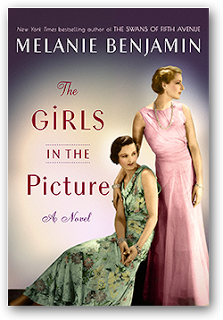
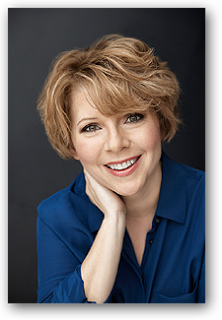
"Benjamin, known for her living, breathing portraits of famous figures, takes on The Golden Age of Hollywood, and the friendship between icons Mary Pickford and screenwriter Frances Marion. As riveting as the latest blockbuster, this is a star-studded story of female friendships, creative sparks about to ignite, and the power of women. Dazzling."
Yep, that's my blurb for Melanie Benjamin's astonishing The Girls in the Picture. It isn't just a deliciously juice read about the friendship between screenwriter Frances Marion and star Mary Pickford. It's a book about female empowerment--and that makes it truly an important read.
The one story I always tell about Melanie is that when I was reading in Chicago, during a blizzard, she drove me back to my bed and breakfast, only to find that my key didn't work. AND SHE STAYED UNTIL I WAS ABLE TO ROUSE THE OWNER AND GET INSIDE. It's little things like that that make her who she is, which is wonderful.
Melanie's other mega-selling novels include Alice I Have Been, about Alice Liddell, the inspiration for Alice in Wonderland; The Autobiography of Mrs. Tom Thumb, the story of 32-inch-tall Lavinia Warren Stratton, a star during the Gilded Age; The Swans of Fifth Avenue, about Truman Capote and his society swans; and The Aviator's Wife, a novel about Anne Morrow Lindbergh. Her novels have been translated in over fifteen languages, featured in national magazines such as Good Housekeeping, People, and Entertainment Weekly, and optioned for film.
Thanks for being here, Melanie!
What made you choose these figures as your next project? And how does this feel personal to you?
I am a huge movie nut, and obsessed with old Hollywood, particularly those very early years. There was just a vibe about it - the creation of a new art form - that attracts me. So I've read a lot of books about this era. And throughout many of those books, this close friendship between Mary Pickford and Frances Marion is mentioned, especially in a book by Cari Beauchamp called "Without Lying Down." I always thought this could be the basis of a great novel, this empowering female friendship of two collaborators working in this wild and crazy atmosphere, and finally, the time seemed right. More right than I could have known; since the book was done, there have been so many explosive bombshells about the way men in Hollywood treat women, and these bombshells echo many of the things that Frances, Mary and their friends first encountered in that early Hollywood.
How was writing this book different than your others?
Every book is different! I find that so exciting; that every novel is a different experience, has different highs and lows in the process. I've learned to embrace that rather than fear it.
I bet the research was lots of fun. What surprised you?
So much of this story I knew already, so there weren't a lot of surprises, to be honest. I do think that the scope of Fred Thomson's fame is not well known today, and it was a bit of a surprise. (Fred Thomson was Frances's beloved husband.) I loved staying at the Hollywood Roosevelt Hotel; it was where some of the very first Academy Award dinners were held, and Mary Pickford was an original investor. It was fun to taste a bit of that old Hollywood glamor.
You’re so well-known now, that I have to ask, do you still have the same primal terror most writers have when they start a project? Or do you feel secure now? Or are you one of the writers who never feels insecure! (And if so, how do I get to be that way?)
I have an odd ability to be one hundred percent confident while I'm writing, and then to be one hundred percent ruthless and pragmatic about the business once the novel is done. If that means ditching it and starting over with something new, fine - I can do that. I have done it, even since I've become better known. That never shakes my confidence in my ability, weirdly; I'm able to say, "Well, that didn't work! Let me try something else!" without being devastated or having my confidence shaken. What I don't always have confidence in is the business part that I can't control. I know that you can write your best book ever but circumstances - timing, whatever's going on in the world, other books out at the same time - can conspire to make it so people don't read that book. And that's the part that still can make me queasy.
Can you talk a bit about what changes these women made on Hollywood and how they might have led to changes today?
Mary Pickford was the first actor to have her own production company. She was the first female head of a major movie studio. She was the first actor to command a million dollars a year, more than any actor (save Charlie Chaplin, who briefly out earned her.) Frances Marion was the first woman to win an Academy Award for Best Adapted Screenplay, and then Best Screenplay. Those are amazing firsts, and they blazed the trail - only to have it grow cold. I think the bigger story here is how these pioneering women's accomplishments did not lead to changes; things grew worse for women in Hollywood after them, as it became a bigger business. We're just starting to regain the influence that Frances Marion and Mary Pickford had, in their heyday. Which is why this book is so timely now, when the issue of Women in Hollywood is such a hot button.
What’s obsessing you now and why?
I'm watching "The Marvelous Mrs. Maisel" on Amazon and loving it! It's what I watch while I treadmill.
What question didn’t I ask that I should have?
You always ask great questions! I could have expounded a bit about how it was, as a writer, to explore another writer in my novel. And it was fun! I was able to give Frances a few of my own quirks--including that weird self-confidence I mentioned above.
Published on January 16, 2018 14:49



